- Games, topic printables & more
- The 4 main speech types
- Example speeches
- Commemorative
- Declamation
- Demonstration
- Informative
- Introduction
- Student Council
- Speech topics
- Poems to read aloud
- How to write a speech
- Using props/visual aids
- Acute anxiety help
- Breathing exercises
- Letting go - free e-course
- Using self-hypnosis
- Delivery overview
- 4 modes of delivery

How to make cue cards
- How to read a speech
- 9 vocal aspects
- Vocal variety
- Diction/articulation
- Pronunciation
- Speaking rate
- How to use pauses
- Eye contact
- Body language
- Voice image
- Voice health
- Public speaking activities and games
- About me/contact
- Speech delivery
Cue cards for public speaking
How to make cue cards & use them effectively.
By: Susan Dugdale
Making good cue cards from standard office supply index or note cards to help you confidently deliver an extemporaneous speech is relatively easy. And using them well will lift the quality of your presentation immeasurably. (Truly! I promise you that's not hyperbole. ☺)
What's on this page
Step-by-step guidelines on how to make cue cards and use them well:
- what are cue cards ?
- the benefits of using cue cards
- the materials required to make cue cards
- the 10 features of an effective cue card
- how to write up cue cards - the 3-step process to get from a speech outline to cue cards that work the way you want them to
- how to rehearse with cue cards
- the difference between cue cards and flash cards
What are cue cards?
Cue * or note cards, used by speakers when making an extemporaneous speech * , are typically handheld. They are about 4 inches by 6 inches in size, with carefully selected and ordered words and phrases written on them. These act as prompt to help speakers remember what they have to say.
* A cue is a signal or a prompt to say or do something. * extemporaneous speech -a well-prepared speech that relies on research, clear organization, and practiced delivery, but is neither read nor completely memorized.
The benefits of using cue cards
People who do not use cue cards to help them deliver a prepared speech either read it from a word-for-word printout or rely entirely on their memory.
However, both these delivery methods have potential traps for the unwary.
- Reading a speech well is a skill and like any skill it needs work to become proficient at it. Someone who hasn't practiced reading aloud is very likely to be difficult to listen to and to watch.
- Opting to deliver a speech entirely from memory is only effective if you've done enough practice. A blank-out and trying to chase down lost words in front of an audience can be hard to recover from. (There is no safety-net!)
Enter cue cards!
The benefits of using cue cards well are:
- Not being anchored to a podium reading the entire text of your speech. This enables you to freely interact with your audience: -to make eye contact, -to observe and readily respond, for instance to clarify a point you can see has not been understood, to leave out bits you can tell are not wanted or needed..., -to gesture and move easily.
- Not being left stranded and floundering because you have forgotten important details, or the sequence of your material. Cue cards are reassuring.
A well-prepared set of cue cards will give you confidence. You will sound, look and feel more present, and your entire delivery will have more life, more energy!
For those of you who are nervous about making the transition from the safety of a complete sentence by sentence script to note cards, don't be. Take it slowly. Give yourself time to thoroughly prepare and rehearse with them, and you'll be delighted with the result.
The materials needed
You'll need a packet of standard index cards, similar to the one in the illustration below, a selection of highlighters, (for example, yellow, pink, blue and green), and an easily-read pen. I suggest using one with either blue or black ink.
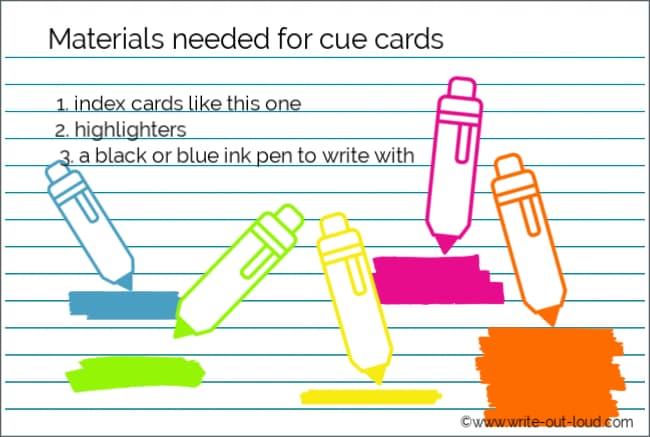
The 10 features of good cue cards
The information you put on your cards and how you lay it out is critically important. You need to be able to read and understand them at a glance. (See the illustration below)
The most user-friendly cue cards:
- have ONE main subject heading or idea per card
- have a heading showing which part of the speech the card belongs to
- are written or printed clearly using larger than usual font - so you can read them easily
- have plenty of white space around each word or phrase to help them stand out
- use bullet points or numbers to itemize the supporting ideas under the main heading
- are written on ONE side of the card only
- are clearly numbered so that you know the order they come in and it can be a good idea to tie them together . Use a hole punch to make a hole through the left corner of your cards and tie with a loop of string long enough to allow them to be flipped. The advantage of that is if you drop or somehow get them out of sequence, you're not scrabbling around trying to get them back into the right order and find where you'd got up to while being watched. That can be tough with dozens of pairs of eyes on you!
- are color-coded to show your main idea, supporting ideas, examples and transitions or links.
- have where props are to be shown . For example: Main Idea One - Supporting Idea - Example - Show slide 1
- have approximate timings marked so you can track yourself through your allotted time. If you find you're going over you can adjust by leaving out an extra example or conversely if you're under time, you can add one in.
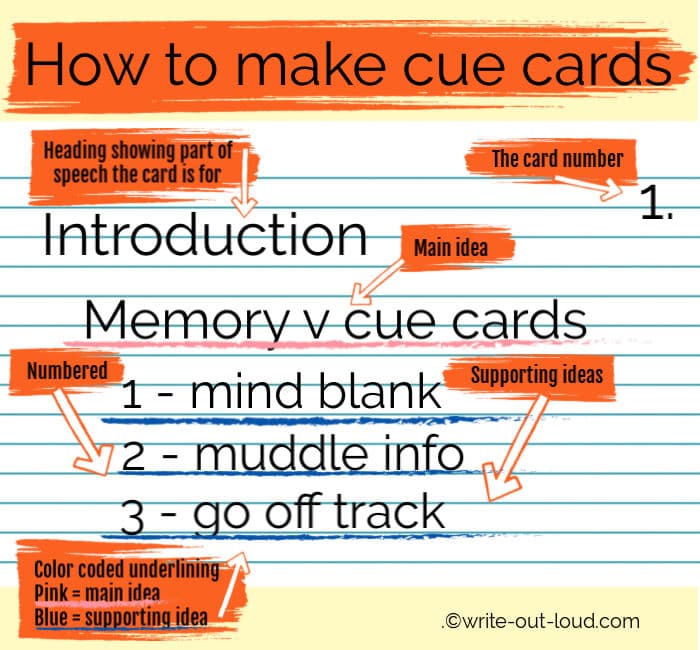
Preparing your speech for cue cards
Before starting the cue cards you need to make sure your speech is fully prepared.
The next 3 steps are an essential part of the preparation process.
1. Reviewing your speech outline
Using your speech outline go through from the beginning checking the sequence of ideas, supporting material and transitions to ensure all your information is in an effective and logical sequence. (And if you haven't made an outline yet download and use the blank one available from the link below.)
Have you outlined your speech?
If you haven't got a speech outline already prepared ...
Use the printable blank speech outline template you'll find on this page: sample speech outline . It will make preparing your cue cards a breeze.
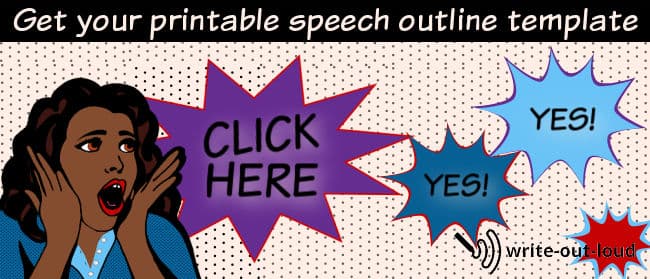
2. Try your speech out loud
Use your outline to try your speech out loud. Say it through as if you were actually giving it and time yourself.
Remember to allow for pausing, waiting for the audience to finish laughing before you begin talking again, and so on.
You may need to edit if it's too long and it's a lot easier to do that at this stage.
3. Feedback
Once you have the length right for your time allowance, ask a few people whose judgment you trust to listen to you give your speech. Have them give you feedback on its content, structure and delivery, paying particular attention to the introduction and the close.
(For more information see speech evaluation| giving and receiving meaningful feedback .)
Use the feedback you've been given to rework your speech if you need to.
When you're satisfied you have it the best it can possibly be, you're ready to prepare it for cue cards.
Getting from outline to writing up your cue cards
Identifying good keywords and phrases.
Each segment or part of your speech, from its introduction to conclusion, should be reducible to a key word or phrase. The phrase or keyword will act as a prompt, or trigger, making you immediately remember what it was you wanted to say.
Before you can write your cue cards you need to go through your speech outline and choose a word or phrase that best represents what each part is about.
Once you've finished, you're ready to write up your cards using the 1-10 guidelines above.
Test your cards as you make them
Double check the effectiveness of each card as you write them to make sure you are using keywords or phrases that actually do trigger your memory.
This is also particularly important for links or transitions. Forgetting how you got from one piece of information to the next not only leaves you stranded but your audience as well.
NB. Be sure to note the names of important people, facts or processes too.
A word of warning
Do not be tempted to print or write the whole of your speech out, then cut it into bits and stick those bits onto cue card sized pieces of cardboard. * It will defeat your purpose entirely.
You'll finish with ridiculously cramped notes that, as well as being difficult to read, stop you from freely interacting with your audience. You'll be head down trying to decipher what you wrote!
* (I've seen it in action! Occasionally one of my student's would try it and the result was never, ever good.)
Rehearsing with your cue cards

You'll find a full page here on ' how to rehearse ' .
It includes notes specifically on rehearsing using your cue cards as well as other valuable tips for delivering your speech successfully.
Now that you've completed your set of cards, please don't shortchange yourself by assuming you are fully prepared and ready for delivery.
To use them well you really do need to practice with them. Before you give your speech aim for at least three concentrated rehearsal sessions and do more if possible.
Cue cards and flash cards. What's the difference?
The principal difference between them is their purpose.
Flash cards are used to help memorize information for example, vocabulary lists for a new language you're learning, the sequence of events leading to the outbreak of WW2, or the names and placement of all the bones in the human body.
They frequently have diagrams and pictures as well as words on them to make the information easier to remember.
The goal or purpose of them is instant recall. They are extensively used by students, particularly as part of their exam preparation.
In comparison, cue cards are generally larger than flash cards and have less information on them - just an ordered sequence of a speech's key words and phrases.
Whereas flash cards are used prior to an examination or test, cue cards are used during a presentation. Their purpose is to prompt or remind the speaker to say what they wanted to.
speaking out loud
Subscribe for FREE weekly alerts about what's new For more see speaking out loud

Top 10 popular pages
- Welcome speech
- Demonstration speech topics
- Impromptu speech topic cards
- Thank you quotes
- Impromptu public speaking topics
- Farewell speeches
- Phrases for welcome speeches
- Student council speeches
- Free sample eulogies
From fear to fun in 28 ways
A complete one stop resource to scuttle fear in the best of all possible ways - with laughter.

Useful pages
- Search this site
- About me & Contact
- Blogging Aloud
- Free e-course
- Privacy policy
©Copyright 2006-24 www.write-out-loud.com
Designed and built by Clickstream Designs

Want to create or adapt books like this? Learn more about how Pressbooks supports open publishing practices.
14.3 Using Notes Effectively
Learning objectives.
- Know how to use notecards to free you from your manuscript.
- Know how to use notecards to stay organized while you make audience contact.
- Understand how to develop effective notecards for a speech.

Dave Gray – Blank index card! – CC BY 2.0.
It’s a great deal of work to prepare a good speech, and you want to present it effectively so that your audience will benefit as much as possible. We’ve already said that extemporaneous speaking provides the best opportunity for speaker-audience contact and that speaking extemporaneously means you do not have your full manuscript or outline with you. Instead, you will use notecards. The cards should have notes, not the full text of your speech. This can also be done with an autocue device—the TelePrompTer does not have to provide a full word-for-word script.
We have developed a system for creating highly effective notecards. Our system has been used effectively both in public speaking courses and in freshman composition courses. Surprisingly, the system consists of only five cards. For many people, this does not sound like nearly enough cards. We would make the case that you can do a good job with five cards, and we have seen many students do just that.
The Purpose of Speaker Notes
Using notes adds to your credibility as a speaker. If you depend on a full manuscript to get through your delivery, your listeners might believe you don’t know the content of your speech. Second, the temptation to read the entire speech directly from a manuscript, even if you’re only carrying it as a safety net, is nearly overwhelming. Third, well-prepared cards are more gracefully handled than sheets of paper, and they don’t rattle if your hands tremble from nervousness. Finally, cards look better than sheets of paper. Five carefully prepared cards, together with practice, will help you more than you might think.
Key Tips for Using Notes
Plan on using just five cards, written on one side only. Get 4 × 6 cards. Use one card for the introduction, one card for each of your three main points, and one card for the conclusion.
Include Only Key Words
Your cards should include key words and phrases, not full sentences. The words and phrases should be arranged in order so that you can stay organized and avoid forgetting important points.
One exception to the key word guideline would be an extended or highly technical quotation from an authoritative source. If it is critically important to present an exact quotation, you may add one additional card that will contain the quotation together with its citation. If you plan to use such a quotation, make sure it has central importance in your speech.
Hold Your Notes Naturally
Notes are a normal part of giving a presentation. You do not need to conceal them from the audience; in fact, trying to hide and use your notes at the same time tends to be very awkward and distracting. Some instructors recommend that you avoid gesturing with your notes on the grounds that nervous shaking is more noticeable if you are holding your notes in your hand. If this is the case for you, practice gesturing with your free hand, or put your cards down if you need to use both hands. Other instructors recommend treating notecards as a natural extension of your hand, as they believe it is distracting to put your notes down and pick them up again. Whichever “rule” you follow, remember that the goal is for your use of notecards to contribute to your overall appearance of confidence and credibility.
Prepare Notecards to Trigger Recall
The “trick” to selecting the words to write on your cards is to identify the keywords that will trigger a recall sequence. For instance, if the word “Fukushima” brings to mind the nuclear power plant meltdown that followed the earthquake and tsunami that hit Japan in 2011, then that one word on your notecard should propel you through a sizable sequence of points and details. Once you have delivered that material, perhaps you’ll glance at your card again to remind yourself of the key word or phrase that comes next.
You must discover what works for you and then select those words that tend to jog your recall. Having identified what works, make a preliminary set of five cards, written on one side only. Number the cards, and practice with them. Revise and refine them the way you would an outline. If you must, rewrite an entire card to make it work better, and test it the next time you practice.
Always practice with your notecards—and with any visual aids you plan to use. Practicing is also the best way to find out what kinds of things might go wrong with your notes in the presented speech and what steps you should take to make things go smoothly.
Write in Large Letters
You should be able to read something on your card by glancing, not peering at it. A few key words and phrases, written in large, bold print with plenty of white space between them, will help you. If the lighting in your speech location is likely to have glare, be sure to write your notes in ink, as pencil can be hard to read in poor lighting.
Using Notecards Effectively
If you use as much care in developing your five notecards as you do your speech, they should serve you well. If you lose your place or go blank during the speech, you will only need a few seconds to find where you were and get going again. For instance, if you know that you presented the introduction and the first main point, which centers on the Emancipation Proclamation, you can readily go to your second card and remind yourself that your next main point is about the Thirteenth Amendment to the US Constitution.
In addition, the use of your notecards allows you to depart from the exact prepared wordings in your manuscript. In your recovery from losing your place, you can transpose a word or phrase to make your recovery graceful. It allows you to avoid feeling pressured to say every single word in your manuscript.
Under no circumstances should you ever attempt to put your entire speech on cards in little tiny writing. You will end up reading words to your audience instead of telling them your meaning, and the visual aspect of your speech will be spoiled by your need to squint to read your cards.
Key Takeaways
- Good notecards keep you from reading to your audience.
- Good notecards are carefully based on key words and phrases to promote recall.
- Good notecards should enhance your relationship with listeners.
- Using the introduction to your speech, create a 4 × 6 notecard that includes the grabber, the thesis statement, and the preview. Test it by standing as you would during a speech and using it to guide you.
- Answer these questions: Is it absolutely crucial to utter every word on your outline? Are there some words or phrases that are crucially important? How can you use your notecards to focus on the most important ideas?
- Select key terms from your speech that you believe will trigger your recall of the sequence of main ideas in your speech. Use them as the basis of your next four notecards. Test the cards by practicing with them to see whether your selected terms are the ones you should use.
Stand up, Speak out Copyright © 2016 by University of Minnesota is licensed under a Creative Commons Attribution-NonCommercial-ShareAlike 4.0 International License , except where otherwise noted.
Share This Book
- PRO Courses Guides New Tech Help Pro Expert Videos About wikiHow Pro Upgrade Sign In
- EDIT Edit this Article
- EXPLORE Tech Help Pro About Us Random Article Quizzes Request a New Article Community Dashboard This Or That Game Popular Categories Arts and Entertainment Artwork Books Movies Computers and Electronics Computers Phone Skills Technology Hacks Health Men's Health Mental Health Women's Health Relationships Dating Love Relationship Issues Hobbies and Crafts Crafts Drawing Games Education & Communication Communication Skills Personal Development Studying Personal Care and Style Fashion Hair Care Personal Hygiene Youth Personal Care School Stuff Dating All Categories Arts and Entertainment Finance and Business Home and Garden Relationship Quizzes Cars & Other Vehicles Food and Entertaining Personal Care and Style Sports and Fitness Computers and Electronics Health Pets and Animals Travel Education & Communication Hobbies and Crafts Philosophy and Religion Work World Family Life Holidays and Traditions Relationships Youth
- Browse Articles
- Learn Something New
- Quizzes Hot
- This Or That Game
- Train Your Brain
- Explore More
- Support wikiHow
- About wikiHow
- Log in / Sign up
- Education and Communications
- Communication Skills
- Public Speaking
How to Prepare Notes for Public Speaking
Last Updated: May 21, 2023 Fact Checked
This article was co-authored by Deb DiSandro . Deb DiSandro is the Owner of Speak Up On Purpose, an organization dedicated to improving and teaching public speaking. Deb has over 30 years of experience as a national speaker and has presented at the Erma Bombeck Writer’s Conference and the National Society of Newspaper Columnists. She was awarded the National Speakers Association Member of the Year 2007 and has been published in Writer's Digest, Daily Herald, Women's Day, and Better Homes & Gardens. There are 10 references cited in this article, which can be found at the bottom of the page. This article has been fact-checked, ensuring the accuracy of any cited facts and confirming the authority of its sources. This article has been viewed 242,676 times.
You have to give a speech, and you wonder how you can give it without staring at a piece of paper. Rather than memorize the words, you can use notes. Notes are easy to make. First, write and refine your speech. Pick out keywords that represent the main ideas of your speech and write them on notecards. Finish filling out the notecards with important talking points. Good notes make you sound natural as a speaker while having a safety net in case you get lost.
Creating and Breaking Down Your Speech

- This is a draft. Pay attention to word choice and sentence structure. Make it as good as possible, but remember that you'll be able to fix any mistakes before you make your notes.
- Get all of your ideas on paper. It doesn't matter if they're crazy, inspiring, or weird. You have a chance to perfect what doesn't work later on. [2] X Research source

- It's a good idea to time yourself while you do this. That way, you'll know when you need to cut down your speech's length.
- Learn transitional phrases to help your speech flow naturally. [4] X Research source

- Highlight things that worked from your first draft and areas that you want to keep that need to be reworded.

- Record your own speech and listen to the phrases and pacing. Listen for any awkward phrases and try to smooth them out in the next draft.
- If you know someone who's given a public speech before, ask them to listen. They will have more experience and will be less biased.

Making Your Notes

- For example, you are speaking about the life of a politician. You can use the word “Military” to show yourself when it's time to talk about their military experience.
- Images can also help solidify the order of your speech. Visualize uniformed soldiers marching in unison and you won't forget you need to talk about military training.
- Write out the first words of your transition sentences to help keep yourself on track.

- For example, if you need to introduce your second idea at the three minute mark, write three minutes on the card containing that idea.

- Write the words in a pen that's legible to you. Black or blue ink works best.
- If you have bad handwriting, you can type out your notes. Cut and glue them onto your notes or print them directly by using the “Size” option in the “Print Layout” tab.

- For example, write out “award” or “Purple Heart” to remind yourself to mention the awards someone earned in service.

- For instance, write down “75% pass” if you need to inform your audience how many people pass a class.

- Customize the color code to whatever works best for you.
- This works best if you color code while you practice your speech, but it could be distracting or confusing by the time you give the speech.

- You can also bind the cards together. Use a drill or hole punch on the upper left corner of the notes. Loop a string through them. They'll be easy to flip and can't be mixed up.
- However, make sure the flipping of the notecards is not distracting to the audience.
Rehearsing Your Speech

- Memorizing a speech word-for-word is unhelpful because the audience can tell that you're reciting a script. Only use memorization and scripted words if you're painting a picture with your words or you need to tell a joke with comedic timing.

- Because you are using a minimal outline, your speech will sound a little different every time. However, it'll also sound more natural.

- You can time yourself again while giving the speech so you know exactly how long it is rather than making a guess. It can show you when you're going off-script too much. Keep in mind when you give the speech, you're bound to talk faster and the speech will be shorter.
Community Q&A
- Research name pronunciations before writing your speech. Thanks Helpful 4 Not Helpful 1
- Try to have 3 main points in the middle of your speech so the audience remembers it well. You can back these points up with further information or quotes. Thanks Helpful 4 Not Helpful 1
- Look at your card quickly and smoothly. Keep your thumb next to the line on your note card so you don't lose your place. Thanks Helpful 3 Not Helpful 1

- When using visual aids, make them sparse and with few words. Visual aids are supposed to be for the audience. Thanks Helpful 0 Not Helpful 1
Things You'll Need
- Blue or black pen
- Colored highlighters
- Index cards
You Might Also Like

- ↑ https://pac.org/content/speechwriting-101-writing-effective-speech
- ↑ https://wrd.as.uky.edu/sites/default/files/1-Shitty%20First%20Drafts.pdf
- ↑ http://writingcenter.unc.edu/tips-and-tools/speeches/
- ↑ https://open.lib.umn.edu/publicspeaking/chapter/10-2-keeping-your-speech-moving/
- ↑ https://www.unr.edu/writing-speaking-center/student-resources/writing-speaking-resources/editing-and-proofreading-techniques
- ↑ http://www.washington.edu/doit/presentation-tips-0
- ↑ https://examples.yourdictionary.com/keyword-outline-examples.html
- ↑ http://academics.umw.edu/speaking/resources/handouts/preparing-speaking-notes/
- ↑ https://www.ted.com/participate/organize-a-local-tedx-event/tedx-organizer-guide/speakers-program/prepare-your-speaker/rehearsals
- ↑ https://www.student.unsw.edu.au/speaking-audience
About This Article

Public speaking can be scary, but using notes can increase your confidence and make it a little easier. To prepare notes for public speaking, begin by writing your speech. Once you’ve written the first draft, read the speech out loud and make any necessary changes so it sounds smooth. When you’re happy with your speech, translate it into notes by highlighting keywords to mark where each new idea begins. Then, write one keyword per notecard. Make sure your writing is clear so you can read it easily as you speak! If you need to remember specific details or statistics, include these on your notecards. For example, you could write ”75%” in your notes if you need to tell the audience how many people pass a class. When you’ve finished making your notes, number each one to avoid getting them mixed up. For more information from our Public Speaking co-author, like how to practice your speech, read on! Did this summary help you? Yes No
- Send fan mail to authors
Reader Success Stories
Conrad Pickl
Oct 17, 2017
Did this article help you?
Zachary Peel
Sep 19, 2021
Megan White
Jul 27, 2016
Tambra Shafer
Oct 15, 2017
Anahi Pizano
Feb 10, 2020

Featured Articles

Trending Articles

Watch Articles

- Terms of Use
- Privacy Policy
- Do Not Sell or Share My Info
- Not Selling Info
wikiHow Tech Help Pro:
Develop the tech skills you need for work and life

How to Use Notes in a Speech: 14 valuable tips for a speaker
- Filed under: Featured articles , Public speaking articles , Public speaking tips and tricks , Speech delivery , Speech preparation
While we’ve already explored the topic of speaking without notes here on my site, I’ve figured I should add a piece about speaking with notes. After all, there is nothing wrong with using notes in a speech, and it is the preferred method of many speakers. I know that there are a lot of times when I choose to use notes during a speech.
So, how do you use notes in a speech? Realize that notes are just notes, and shouldn’t be the full manuscript of your speech. Cue cards can be very effective when speaking in public. Make sure you are writing down keywords and phrases to remember. Try not to look down at your cards too much.
There are many benefits and also tricks to using notes during your speech. It’s okay if you aren’t experienced with this skill yet, because everyone has to start somewhere. If you’re really serious about learning to properly utilize this in your presentations, then I am going to show you some of my best tips. Read on!
Meanwhile, if you want to be a better public speaker, I have compiled a great list of the best public speaking books you definitely should read. Check out these books here
Table of Contents
How to Use Notes in a Speech
When you are using notes, remember that how you use them is more important than anything. Almost everyone does notes differently, so it can help you to ask for advice from a trusted friend or mentor. And you should always remember to let things flow and be natural. If you are awkward and acting less than natural onstage, your audience could feel uncomfortable.
And above all, if you are in the middle of your speech and something is not going as you planned in your notes? That is perfectly okay. Not everything can be planned for, and sometimes you just have to go with the flow.
#1 Identify if You Need Notes or Not
There may be times when it is more or less appropriate to use notes, or not. For the most part, it is your choice. However, there are some other factors you should consider:
Maybe it is required to use notes
Some places where you speak may explicitly require you not to use notes. This also includes certain formats such as TED talks or short toasts. Make sure to find out whether or not using notes or not using notes is preferable at your venue, and for your style of speech.
It is not allowed to use notes
If you are explicitly not allowed to use notes. This may be the case if you are giving a presentation at school, or a speech as part of a verbal essay.
How long is your speech?
Is your speech too short to warrant the need for notes? Most of the time, speakers don’t use notes if their presentation is less than six minutes or so.
Delivering a keynote speech at a major event, teaching an educational course that is multiple days long, or giving a speech that is too long to memorize are good times that it is appropriate for you to use notes.
When you assess whether or not you should use notes, you avoid a lot of confusion when you show up to give your speech. You also avoid a potentially awkward situation. This goes right along with something that I am always telling my colleagues and students: be prepared!
If you are somehow here because you need to know how to give a speech without notes, check out the article that I have done here about that subject. For the rest of this article, we will exclusively be talking about public speaking with the use of notes. It’s important to say, though, that there is nothing inherently wrong with either method.
Creating and Planning Your Speech is a Great Start
Now, let’s talk about creating and planning your speech with the use of cue cards. If you know anything about me, you know I’m a bit fan of planning your presentation out as much as you can. After all, planning and practice both make perfect!
Here are some steps you should take to plan your speech out with notes using cue cards:
Recommended books
How to Deliver a TED Talk: Secrets of the World's Most Inspiring Presentations
Jeremy Donovan
Resonate: Present Visual Stories that Transform Audiences
Nancy Duarte
Confessions of a Public Speaker
Scott Berkun
Talk Like TED: The 9 Public-Speaking Secrets of the World's Top Minds
Carmine Gallo
The Checklist Manifesto: How to Get Things Right
Atul Gawande
The First 20 Hours: How to Learn Anything... Fast!
Josh Kaufman
#2 What is the purpose of your speech?
Knowing the purpose of your speech is always the first step. What is the reason you are speaking? What cause are you trying to further? Get out a piece of paper, and write the purpose of your speech at the very top in big letters.
This is something you need to keep in mind throughout the entire process so that you don’t lose sight.
#3 Draft and outline
Write a draft with an outline prepared. Make sure to underline or highlight key points of your speech.
#4 Tweak your draft
Go through your draft as many times as possible to add or subtract anything that you need to. Take this time to fix any mistakes you may have made.
#5 Let someone else take a look
Have a friend or mentor look over your draft for you, since they may be able to give you some proofreading tips. If you know someone who is good at writing or is an English major, they may be best able to help you.
#6 Prepare your cards
Then, take your cue cards and write down the key ideas of your outline onto the cards.
Try to select one main idea per card. If you cram too many ideas onto one card, this may end up getting confusing. It could even cause you to lose your place. Also, make sure you are writing legibly at all times.
#7 Prepare for the time limit
If your speech has a time limit, write on each card how much time you should spend on each particular idea.
#8 Number your cards
Number your cards if applicable so you know what order you are going in.
#9 Write Interaction Reminders or Important Facts
As I mentioned before, notes are a better choice than using a scripted speech if you want to maximize the connection with your audience members. That is why it is a good idea to include reminders to interact with your audience on your note cards.
Here are some interaction reminders you could write for yourself:
- “Ask Poll Question”
- “Change Slide”
- “Flip Chart”
- “Give Five Minute Break”
- “Distribute Handout”
And if you have any exact information that you need to remember, such as percentages or names, you should write this down to remember.
When I give this piece of advice, many students have told me that they are worried that writing down interaction reminders with make them look too unnatural or scripted. But interacting with your audience is just as important as what you have to tell them.
With practice, your audience interaction won’t look unnatural even if you have to remind yourself when to do it.
#10 Are You Using PowerPoint Slides?
PowerPoint slides can be very helpful for a lot of things. And while they can be a great visual aid for your audience, you should not use them as a substitution for regular notes.
Why? Well, this will be too much material for your slides. And the PowerPoint is supposed to be used as a visual aid, not as the sole source of information. After all, what do you need to speak for if all of your information is available on your slides?
#11 Practice, practice, practice
When you are completely done writing out your notes, practice reading them during your rehearsal. This will help you identify any possible problems before the day of your presentation.
When you effectively plan out your speech and your note cards, you will be best prepared when the big day comes. And being prepared for your speech is one of the best things you can do.
Notes Aren’t a Manuscript for the Entire Speech
There are times when reading from a full script is appropriate, or required. But in general, notes are considered a better overall way to speak to an audience. Why? Well, that is because notes give you more of an opportunity to be yourself onstage.
Don’t allow your use of notes to reduce how you are able to connect with your audience. What if you are reading from a full script, and someone asks a question that interrupts that script? This is exactly why your notes should only represent a general outline and reminders, not an entire script.
#12 Use bullet points instead of a full script
Here are a few other reasons you should use notes or bullet points instead of a full script:
- Full scripts require you to constantly be looking at a piece of paper, but this looks unnatural . You should be giving some attention to looking at your audience, and focusing on your hand gestures.
- Writing out only specific key phrases can help you remember what you want to talk about , while also giving you some freedom to improvise when needed.
- Not having to look at a full script will give you the freedom to move around the stage.
- You have a guide with notes, but you are not fully committed to the full word-for-word script, which gives you flexibility.
While reading from a full script shouldn’t be completely thought of as bad, I often find that it is easier to talk more freely and connect with the audience better when I am not chained to a script. But the security of having notes or a set of bullet points on hand can help greatly when the time comes.
#13 Cue Cards Help Tremendously
Should you use regular paper, or note card stock?
A regular paper can be great for the planning stages, but you will definitely benefit in the long run from having your notes on smaller cue cards. Cue cards also look more graceful when you are handling them onstage.
Plus, what if you get nervous and your hands start to shake? A larger piece of paper will make the shaking more noticeable to your audience.
Heavy card stock is a good choice. This way, your notes are less likely to blow away if there is a fan, air conditioning, or it is windy and you are outside. However, you should also be prepared to bring a paperweight with you, just in case. You don’t want to end up chasing your notes around instead of giving your speech!
If you are used to giving speeches with a full script, and now you’re looking to switch to note cards, try to give yourself a smooth transition . It might take a little while to get used to doing things differently. This is why rehearsal, asking for help from a mentor and revising your notes many times before the actual speech is good ways to prepare.
#14 Don’t Constantly Look Down at the Notes
Giving eye contact to your audience members is a good way to connect with them during a speech . But constantly looking down at your note cards can have the opposite effect, and make you look more distant.
Throughout your speech, make sure you are putting forth an effort to look out into the audience, make eye contact, and smile. You should also make gestures with your hands, when appropriate. (If you need more tips on what to do with your hands, check this out ).
However, you shouldn’t constantly apologize when you glance down at your notes. Your audience members are forgiving, and they know that sometimes, speakers need to make good use of note cards. Remember, they won’t care that you are using notes , so don’t be self-conscious!
You should not be trying to hide your cards from the audience. If you’re making it look like you have something to hide, you are making yourself look suspicious. Try to treat your note cards like a natural extension of your own hand.
Try recording yourself doing a practice run of your speech. If you notice yourself looking down at the note cards too much, then try making an effort to look out into the audience a bit more.
Is it Professional to Use Notes in My Speech?
After we’ve made it this far, maybe you are still wondering whether or not it is professional for you to use notes when giving a speech. Believe it or not, but I get asked this question all the time from students, friends, and other speakers. It makes me baffled to think that people still believe that using note cards in a speech could be unprofessional.
Listen to me when I say that there is nothing unprofessional about using notes in your speech . In fact, until the rise of the note-less TED talk format, it used to be common for most speakers to use notes during their presentations.
When I speak to students, it seems that they are mostly afraid that using notes indicates a lack of self-confidence. Or worse, they are afraid that they appear uneducated or unprepared. But that couldn’t be further from the truth.
What if you were in the middle of your presentation , and you forgot to talk about a key part? It was very important and forgetting it threw you off track for the rest of the speech.
In the end , your audience was confused about the purpose of your speech, and you came off looking very unprepared. Some people just give better speeches if they have notes. And if that describes you, then you absolutely should have notes.
After all, why put yourself at risk of forgetting something important? If you are worried about the opinions of someone else, don’t be. After all, they are not the ones giving your speech for you, and you have to do what will help you give your best speech.
To many, using notes indicates that you took the time to thoroughly prepare. And if you are new to a topic or inexperienced in the subject material, notes can be a lifesaver for you. So use notes without a worry , because it is absolutely not unprofessional.
Conclusion: How to Use Notes in a Speech?
Today, I hope you have learned something valuable about speaking with notes. Giving a speech with proper notes can be a great way to be prepared for an excellent presentation. As long as you are fully prepared, you have absolutely nothing to worry about. And if you have anything else to share about using notes during a speech, make sure to leave it in the comments section!
Are you looking for good tips to end a speech on a powerful note? Check out my article here , for several tips to properly end a speech. There are also many more articles on how to give a good speech on this website.
Related Questions
Is it okay for me to read a speech? It is usually better for you to read notes instead of an entire speech. If you have to read a full manuscript, that is also okay. Make sure you do what feels comfortable. Leave room to be able to connect with your audience.
How do I prepare for a speech? Make sure you know the purpose of your speech from the beginning. Take time to plan and create your notes if you are using them. Practice and rehearse as much as you possibly can. Rehearse in front of a friend or family member who can give you feedback.
How do I use your my effectively in a presentation? Watch your volume, and be mindful of your intonation. Speak clearly at all times when you are giving a speech. Place emphasis on the right words. Make sure you pace yourself accordingly. Pause when appropriate. (full article here)
Posts about public speaking you may also like
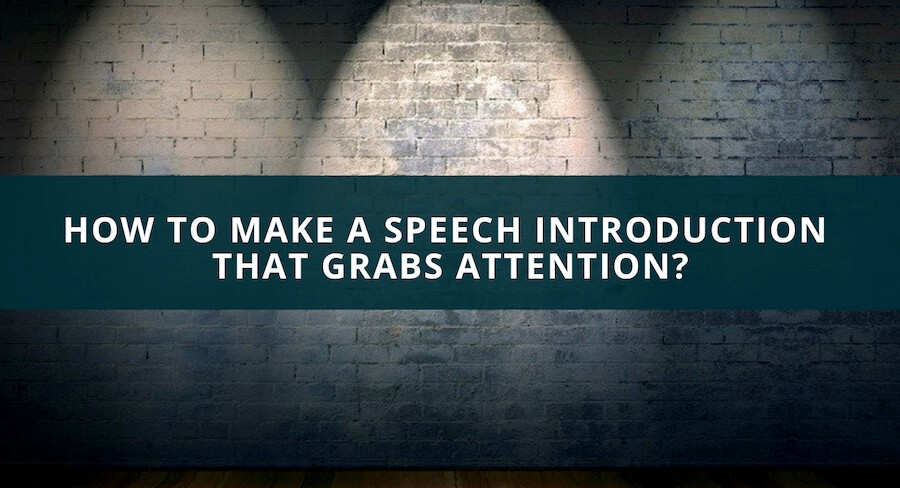
How to make a speech introduction that grabs the attention?
A speech introduction plays a big role in how well you manage to grab attention. The problem is that the majority of introductions lead the

How to deliver a perfect elevator pitch?
First of all, what the heck is elevator pitch and why do we need to do it? So, what is an elevator pitch? An elevator

How to Outline a Presentation: A Complete Guide From a Pro
When you’re writing an important speech, you must start with a clear outline. However, I find that many speakers are uncertain of how to write
- Tags: Good speech , Illustrating your speech , Making a speech , Prepare a speech , Prepared speech , Presentation techniques , Public presentation , Speech preparation process , Speech skills , Speech writing tips , Unprepared speech topics , Writing a speech
Recommended gear

Best Portable Speakers For The Presentations

Best Video Cameras for Public Speakers

Best rresenter remotes for public speakers

Best Portable Thumb Drives And Hard Drives for the Presentations
Who is janek tuttar.
My name is Janek Tuttar , and I am the founder and author of Speak and Conquer website.
I have been teaching public speaking at Estonian Entrepreneurship University of Applied Sciences
Here, I am sharing the wisdom of how to cope in different public speaking situations.
More information about Janek »

Share this post

Hi! My name is Janek Tuttar, and I am the founder and author of SpeakAndConquer.com.
I have been teaching and blogging about public speaking since spring 2007. Here, I am sharing the wisdom of how to cope in different public speaking situations.
Send me an e-mail: [email protected]
LEGAL INFORMATION
This site is owned and operated by Janek Tuttar. SpeakAndConquer.com is a participant in the Amazon Services LLC Associates Program, an affiliate advertising program designed to provide a means for sites to earn advertising fees by advertising and linking to Amazon.com.
This site also participates in other affiliate programs and is compensated for referring traffic and business to these companies.

Best teleprompters

Best Computer Mice for the Presentations

Best Laptop Backpacks for Public Speakers
- Newsletters
- Best Industries
- Business Plans
- Home-Based Business
- The UPS Store
- Customer Service
- Black in Business
- Your Next Move
- Female Founders
- Best Workplaces
- Company Culture
- Public Speaking
- HR/Benefits
- Productivity
- All the Hats
- Digital Transformation
- Artificial Intelligence
- Bringing Innovation to Market
- Cloud Computing
- Social Media
- Data Detectives
- Exit Interview
- Bootstrapping
- Crowdfunding
- Venture Capital
- Business Models
- Personal Finance
- Founder-Friendly Investors
- Upcoming Events
- Inc. 5000 Vision Conference
- Become a Sponsor
- Cox Business
- Verizon Business
- Branded Content
- Apply Inc. 5000 US
Inc. Premium

How to Use Notes When Public Speaking Without Losing Your Audience
Your notes shouldn't become the focus of your presentation..
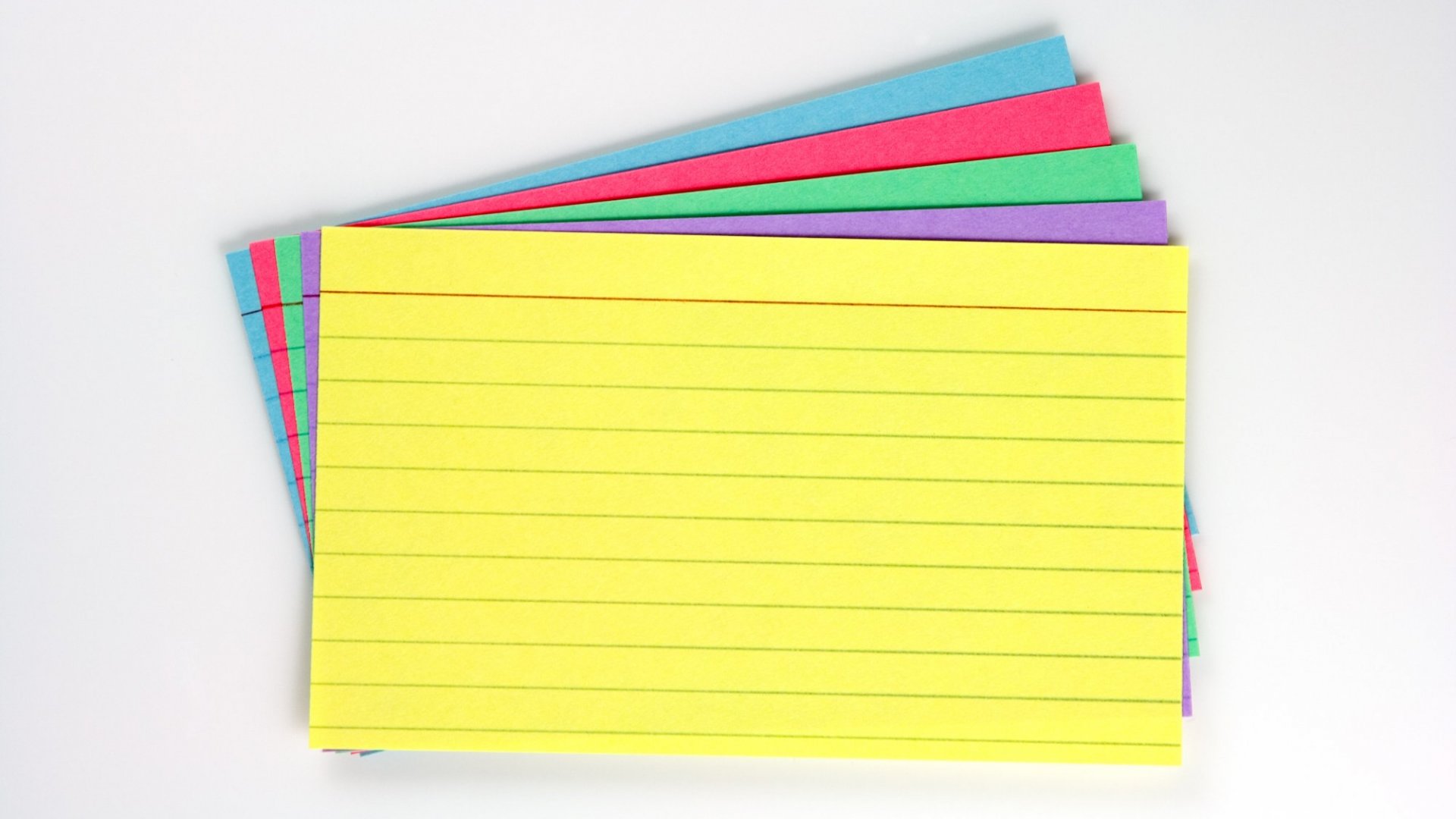
As a professional speaker and speaking coach, I rarely refer to notes while I'm actually speaking, and that's for three reasons: First, it's my job to know my content inside and out. Second, because my presentations are interactive , I have multiple opportunities to check my notes while my audience is doing an activity or having a discussion. Third, having spent seven years performing improvisational comedy , I can usually "wing it" for a few minutes until I gather my thoughts, without the audience noticing.
But if you're not a professional speaker, an interactive workshop leader, or an improvisational comedian, you may find that you need notes to feel more confident presenting. And if you're not lucky enough to have a "confidence monitor" (that flat screen at the foot of the stage that allows a speaker to see his slides without breaking eye contact with the audience) you may have to rely on old-fashioned paper to bring up with you.
Here are 10 tips for successfully speaking with notes so that you're still connecting with the audience more than you're connecting to that piece of paper.
1. Look polished
Make sure any hand-held notes look crisp and professional from the audience's perspective. Don't bring a stack of crumpled up papers with you. Use clean pieces of white computer paper or index cards, on which the ink isn't visible from the back of the page.
2. Write big
Write your notes in large enough font that you can simply glance at them and access the information you need. You don't want to be squinting and scanning the page for the next thing you're trying to say.
3. Number them
Write large page numbers on each sheet of paper or index card. That way, if they get shuffled or out of order, you can quickly find your place.
4. Practice
If your presentation requires you to stand at a podium, practice delivering the presentation so that you're referencing your notes as rarely as possible. Your rehearsal should also prepare you for when you move to the next page. Avoid turning pages in the middle of an important idea, a quotation or a story. Look for natural breaks between main points to turn the page.
5. Plan your moves
If you're going to be moving during the presentation (which I highly recommend), put your notes down on a table or a podium when you're not using them, as long as you won't need them frequently. It's more distracting to watch you keep walking over to pick them up from a table then for you to just hold them in one hand.
6. Choose the right (or left) hand
While you're using notes, hold them in your nondominant hand. Anchor that elbow to your waist and hold your notes firmly, with limited movement. Use your other hand to gesture. Don't gesture with the hand holding your notes--the flapping paper or pile of cards will be a distraction to your audience.
7. Don't read
Your notes shouldn't serve as a script you're reading verbatim. Look at your notes, scan them quickly, and then turn your eye contact back to the audience and resume speaking. Otherwise you'll look like your audience is your stack of index cards.
An exception to "don't read your notes" is when you want to make it clear that you're deliberately reading for the sake of accuracy, such as offering an important statistic or a direct quotation. You might even signal this to the audience by saying something like, "I'd like to read our Vision Statement aloud so that we're all clear on where we're going."
8. Distract from the notes
Think of your notes as a bright shiny object. Chances are, your eyes and your audience's eyes will be drawn to those notes are unless you use them carefully, strategically, and infrequently. Make up for the use of notes with powerful body language and vocal variety.
9. Challenge your assumption
Many presenters discover that their notes are like a security blanket--they thought they needed them for comfort and reassurance, but they realized that they never looked at them throughout the presentation. If you don't need them, don't bring them up with you.
10. Don't apologize
You may wish you didn't need notes, but if you do, then use them without apology. Saying, "I'm sorry that I have my notes up here with me" or "there's too much for me to remember" or, worst of all, "I didn't have time to prepare" undermines your credibility, insults your audience, and draws attention to something you'd rather not highlight.
Mark Twain once wrote: "It usually takes me more than three weeks to prepare a good impromptu speech." Make sure you put the time, energy, and effort into looking and sounding comfortable, prepared, and confident-- even if you're using notes.
A refreshed look at leadership from the desk of CEO and chief content officer Stephanie Mehta
Privacy Policy
Preparing and Using Notecards
Preparing and using note cards (view pdf), preparing note cards.
- Use 3x5 note cards and write on only one side of the cards.
- Use visual cues to help divide up information. If your speech has been outlined, use those indicators to set up the organization of your cards.
- Use fewer words. Just write enough to jog your memory.
- Divide information onto separate note cards in a way that makes sense to you. You may want to start a new card for each main point, or put a direct quote on its own card so it stands out to you.
- Include cues (e.g., “point to slide” or “pause”); write these in a different color or highlight them so you recognize that they are not part of your actual speech.
- Number your cards.
- Use these cards in practice so you are used to the feel and flow. If something isn’t working (e.g., you don’t understand what you wrote), you can still fix it.
- Consider marking approximate time points on the cards so you can pace yourself during the speech (e.g., when you get to Card 3, you should be at about halfway through your speech time. If you are past that, you will need to shorten some of your content.)
Handling Note Cards
- Practice! You should get comfortable using the cards.
- Before you stand up to speak, make sure your note cards are in order.
- Try not to fidget with the cards. You may find it helpful to only hold them in one hand at a time to resist bending or flipping them.
- If you have a lectern or podium, you can rest the cards on the surface.
Office / Department Name
Oral Communication Center
Contact Name
Amy Gaffney
Oral Communication Center Director

Help us provide an accessible education, offer innovative resources and programs, and foster intellectual exploration.
Site Search

Cue Cards Keep Speakers On Track

Cue cards , also known as note cards , contain either the key points of a speech (or the entire text) to help a speaker stay on track or jog the memory if the speaker has not memorized the speech. They can help the speaker pace their talk for extemporaneous speeches.
If you’ve ever given a speech or presentation and forgotten what you intended to say or in what order you wanted to make your points, you understand the usefulness of cue cards. The seemingly insignificant reminders written on what are typically small cards can be a lifesaver in many instances.
Table of Contents
What Are Cue Cards Used For In Speech Making?
Cue cards are an essential tool for public speakers and presenters. They help the speaker remember important points, facts, and figures during a speech or presentation .
Using cue cards, the speaker can maintain eye contact with the audience while delivering a well-organized and coherent message. They also help ensure the speaker doesn’t miss any important information or points during the presentation, which can be crucial when making a persuasive argument or delivering a compelling message.
In some cases, cue cards assist with transitions between different parts of the speech or remind the speaker of specific examples or stories they want to share.
Cue cards come in many variations depending on the speaker’s preference. Some speakers prefer to write their entire speech on cue cards, while others only write down key points or phrases. In some cases, cue cards can take the form of a PowerPoint presentation, in which case the slides can prompt the speaker through each part of the speech.
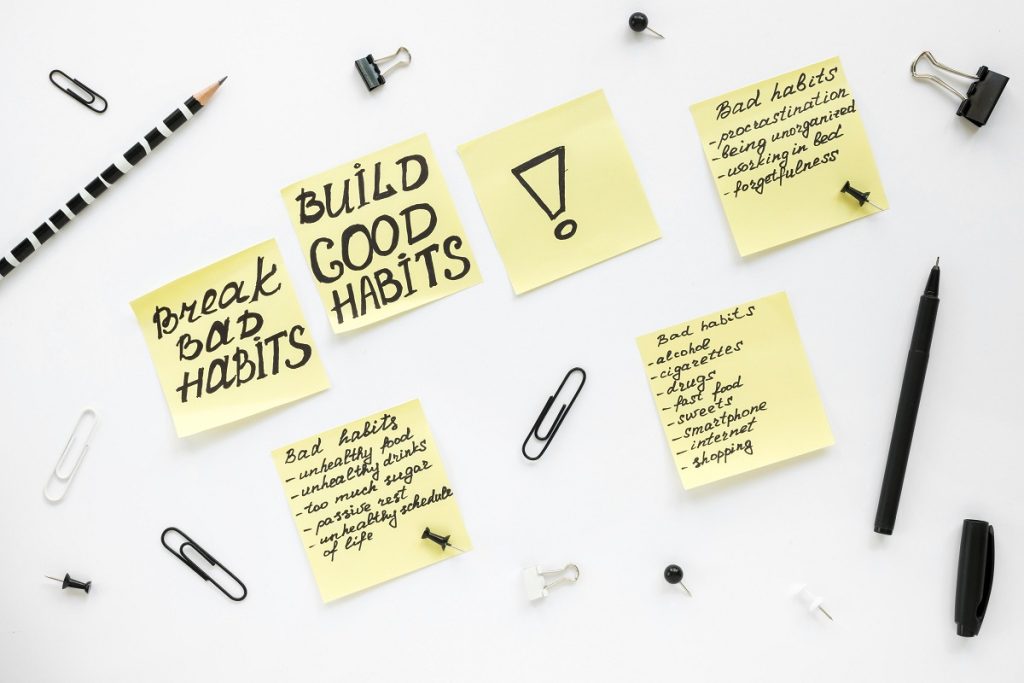
What Are The Benefits Of Using Cue Cards?
Cue cards are an effective way to organize information and create prompts to ensure a speech goes smoothly. That’s not the only benefit of using cue cards, however.
Among the additional advantages of using cue cards are.”
- Helping to keep you focused and on track during presentations or speeches.
- Ensuring you remember all essential points.
- Making eye contact and audience engagement easier . By having a clear and concise outline of your presentation or prompts, you can maintain better eye contact with the audience, which helps to build rapport and keep the audience engaged.
- Reducing anxiety and nervousness when speaking in front of an audience. Having key points written down makes it easier to feel confident in your ability to deliver information and avoid stumbling.
- As a reference tool for future presentations or speeches. By keeping cue cards organized and accessible, you can refer back to them whenever needed, saving time and effort in preparing for future events.
Are Cue Cards Still Used?
Cue cards have been a visual aid staple of public speaking for decades. They’ve been used by politicians, actors, and anyone who needs to deliver a speech or presentation.
However, with the rise of technology and the availability of teleprompters, cue cards have often taken a backseat.
But the answer is yes; cue cards are still used in certain situations. Teleprompters may have become more prevalent in recent years, but cue cards still have their place.
Improv shows and late-night TV are areas where handwritten cue cards are still used regularly. Shows l ike Saturday Night Live (SNL) have teams like the one led by Wally Feresten dedicated to creating handwritten cur cards to help facilitate the performances.
The cue cards for the iconic “Live From New York” show are revered by the show’s performers – so much so that Seth Meyers, known for his Weekend Update bits, has his final cue card framed and hanging in his home .
Cue cards offer a level of flexibility that teleprompters can’t match . For example, cue cards can be easily adjusted on the fly if there is a technical issue with the teleprompter or if the speaker wants to make an impromptu change to their speech.
Additionally, cue cards give presenters flexibility and the ability to maintain eye contact with their audience while delivering their speech. This helps to build rapport and engage listeners.
What Is The Difference Between Cue Cards And Flashcards?
Cue cards and flashcards are both commonly used study aids, but they serve different purposes.
Cue cards, or note cards, provide a speaker with a brief outline or critical points of a speech or presentation. They’re designed to be used as a memory prompt, helping the speaker to deliver their message more effectively.
Cue cards are also typically larger and contain fewer details than flashcards. They’re generally used in public speaking or oral presentations to help the speaker stay on track and remember key points.
On the other hand, Flashcards are used primarily for memorization and recall. They’re small cards, typically index cards, that contain information on both sides and are intended for study aids to memorize facts, concepts, or vocabulary.
Flashcards are often used for test preparation and other academic settings. They’re generally handwritten, portable, and a great way to practice active recall, which is the process of trying to retrieve information from memory.
The major difference between cue cards and flashcards is their purpose.
Cue cards are used as a memory prompt for a speaker, whereas flashcards are used for memorization and recall purposes.

Are Their Downsides To Using Cue Cards?
Although cue cards can be helpful, there are downsides if you become too reliant on them. For instance, reading directly from the cue cards can cause your speech to sound canned and too speechy.
There are things you can do, however, to prevent cue cards from being a problem.
The following public speaking tips for using cue cards as part of your speech can help you deliver your presentation successfully:
- Keep the cue cards simple and easy to read . This means using large font sizes and avoiding cluttered layouts. Additionally, bullet points or short phrases rather than complete sentences are advisable.
- Practice! Using cue cards effectively requires a lot of practice before the actual speech. Familiarizing yourself with the content will reduce the need to constantly refer to the cards during the speech. Reading your speech off cue cards word for word will prevent your audience from connecting with you.
- Place the cue cards at the appropriate spot . This may mean holding them at a proper distance and angle from your face. If a camera’s involved, ensure the cue cards are just to the side of the camera and flipped as needed.
- Be sure to maintain eye contact with the audience as much as possible while referring to the cue cards when needed. This will help keep their attention on the speaker rather than the cards.
By following these tips, cue cards can be a helpful aid in public speaking without becoming a distraction.
How Can They Be Useful For Remote Meetings, Interviews, And Presentations?
In remote meetings, cue cards can be especially useful as they help keep the discussion focused and on topic . They also ensure that all participants have access to the same information, making it easier for everyone to follow along.

During interviews, cue cards can remind the interviewee of key points they want to make or questions they want to ask. This helps them stay calm and composed while ensuring they don’t forget anything important.
Lorin Harrott
After years as a professional speaker and corporate trainer,Lorin Harrott has turned her attention to sharing her knowledge through writing. She's currently a writer, photographer, and mom in Sacramento, CA, with occasional speaking engagements related to education and STEM topics in the public school system.
Recent Posts
Active Listening Absorbs The Whole Message, Not Just The Words
Active listening goes beyond hearing the words someone is saying to you and understanding the message they are conveying. Many only hear a small percentage of what is being said as they are...
Counteracting Fear Of Public Speaking With Coaching And Therapy
Nearly 75% of people experience the social phobia of fear of public speaking. The result may be nervousness before speaking or a full-blown panic attack. Practicing public speaking may lessen the...

55 Speaking Notes and Practice: Reminders and Additional Tips
Learning Objectives
Use notes wisely and effectively
- Create effective notecards that enhance your speech delivery.
- Rehearse your speech for an extemporaneous delivery.
Preparing for Your Speech Delivery
As we have learned, speech making is a process of sequential steps that will help us to deliver an effective speech. We are now at our final speech preparation steps – again! Below are some reminders as well as additional tips to help you finish your preparation for a successful speech delivery!
Preparing Notes
Once you have created a comprehensive outline and have thought through your speech, you should be able to create your note cards or whatever you might be using (notes or an iPad for instance). Every speaker is a bit different, and different speech topics and organizational patterns may require different notation techniques.
Tips for creating and using your note cards
Your note cards (or cue sheets) must have enough information on them to be able to deliver the speech without missing details; they should be organized in the precise order that you have planned. When you are finalizing your speech making process and putting the finishing touches on your outline, you are ready to make the notecards. DO NOT make note cards before you are done with your speech making process. Your note cards should only contain a few words that will guide your speech. You will read your outline word-for-word if you use an outline; so, it is essential for you to spend time on creating note cards. Once you have created effective note cards, you will want to practice with your visual aid, your note cards, and any other props you have to ensure a strong delivery.
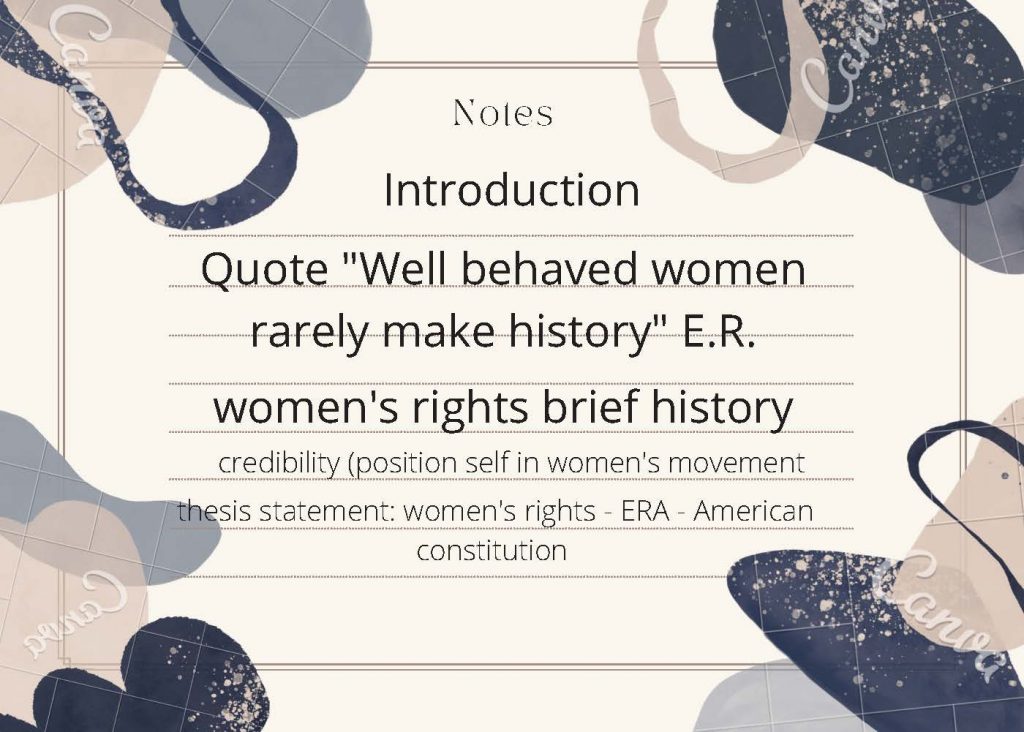
During the delivery:
- You should be able to glance at the cards, get your bearings, and look back at the audience. If you are reading the cards word-for-word, there are too many words on them, unless it is an extended exact quote, or group of statistics that must be delivered precisely.
- Be sure your notes or cards are numbered (e.g., boldly in the upper right hand corner), so you can keep them organized. Color-coding is often done to easily distinguish the cards at a glance. Losing your place can be very stressful to you and distracting to the audience.
- Avoid writing or printing on two sides; flipping a page or card is distracting to the audience. The audience should not be aware of the notes. It is best to simply slide the cards aside to advance to the next card.
- Rehearse your speech using the notes that you will bring to the podium. Be sure you can glance at the notes, get your information, and look up to have eye contact with the audience.
Watch this quick Youtube video to learn how to use notes effectively in a speech. There are great ideas to overcome bad habits and engage in “good” note card use.
Rehearsing the Speech
Students under estimate the amount of time the goes into outlining, creating note cards, and rehearsing their speeches. This “tying up loose ends” is essential for a strong speech delivery. Here are a few tips to remember before you deliver your speech.
Rehearse your speech – aloud and ideally with a colleague or fellow student as an audience
- Rehearse in front of a mirror if needed.
- Think of doing a quick SWOT analysis. What strengths are present? What weaknesses are present? What opportunities for improvement do you have? What threats exist?
- Practice as if you are LIVE. Use the same technology, presentation aids, notecards and/or tangible props.
- Use a timer – consider writing the time on your note cards to keep yourself on track with the pace of your speech.
- Create a practice timeline that will allow plenty of revision time, editing of your outline, and updating your note cards for delivery. Be sure to implement feedback in order to strengthen your argument.
You should also know exactly how your speech will begin and end. Regardless of how dependent on notes the speaker may be, here is one constant word of advice: know exactly how you are going to begin your speech. Not just an idea, but verbatim, with every inflection, every gesture, every eye contact with the audience. The first few sentences should be so ingrained, that you could perform it during an earthquake without batting an eye.
A memorized introduction accomplishes several goals. First, it gives you the opportunity to breathe, and realize it’s not so bad to be up there after all! Second, it lets the audience know you are prepared. Third, it signals to the audience that what you are about to say is important. Finally, it gives you the opportunity for direct eye contact (because you are not reading) and commands the audience’s attention. Eye contact is a signal to the audience that you care about them!
The conclusion of your speech is equally important. In show business parlance, the end of a song or a scene is called a “button.” It is a “TAH-DAH” moment that lets the audience know you are finished, and that it is their turn to applaud. The ending impression your speech leaves with the audience is greatly affected by how effective the ending is. The content and structure notwithstanding, you should also know exactly how you will end (verbatim), so there is no hesitation, no stumbling, no tentative “I guess that’s all” feeling. A confident and decisive beginning will draw the audience to you; a confident logical ending will be very effective in preserving a lasting impression on the audience.
One of the key elements to an effective speech is our delivery method. We are presenting speeches, not reading them . Our goal is to deliver our speeches extemporaneously.
Extemporaneous speaking is one of the most natural methods for delivering a prepared speech. You can use an extemporaneous speech to achieve a more natural tone, flow, and style with the audience. This requires extensive preparation and practice.
| Figure 12.1: Rehearsal Checklist |
|---|
To prepare for an extemporaneous speech, you must understand the difference between your preparation outline and speaking notes.
- Your preparation outline helps you to get prepared for your speech by providing the opportunity to organize and write your ideas in a speech format. This is your “formal” outline you use to organize your ideas (it is also the outline you turn in to me).
- Your speaking notes help you achieve a conversational and natural speech delivery.
See these tips for creating speaking notes:
https://www.wikihow.com/Prepare-Notes-for-Public-Speaking
Another Guide to Preparing Speech Notes
Speaking notes have an advantage over preparation outlines. For example, you can easily look at your notes for reference and as a personal reminder of which topics to discuss as you’re speaking.
Speaking notes commonly take two forms: alphanumeric and decimal.
An alphanumeric outline includes a capitalized number or letter at the beginning of each topic. Look at the sample:
Thesis statement: E-mail and internet monitoring is an invasion of employees’ rights
I. The situation: Over 80% of today’s companies monitor their employees.
….A. To prevent fraudulent activities, theft, and other workplace related violations.
….B. To more efficiently monitor employee productivity.
II. What are employees’ privacy rights when it comes to electronic monitoring and surveillance?
….A. American employees have basically no legal protection from mean and snooping bosses.
……..1. There are no federal or State laws protecting employees.
……..2. Employees may assert privacy protection for their own personal effects.
….B. Most managers believe that there is no right to privacy in the workplace.
……..1. Workplace communications should be about work; anything else is a misuse of company equipment and company time.
……..2. Employers have a right to prevent misuse by monitoring employee communication.
Decimal outline
The decimal outline shows how each item at every level relates to the whole sample.
Thesis statement:
1.0 Introduction
….1.1 Brief history of Liz Claiborne
….1.2 Corporate environment
2.0 Career opportunities
….2.1 Operations management
……..2.1.1 Traffic
……..2.1.2 International trade and corporate customs
……..2.1.3 Distribution
….2.2 Product development
You will note that in both examples, only keywords are used. You can handwrite or type your notes on either a sheet of paper or note cards. The important point is that you do not have a word for word speech – you only have reminders on your key points. This seemingly small difference helps you to have a natural and conversational delivery.
Practice and Rehearsal Guidelines
The following guidelines are best practices on how to practice and rehearse an extemporaneous speech:
- Speak in a conversational style by pretending you are with your audience.
- Rehearse with your graphics and coordinate them with your talk.
- Display your graphics only when you are talking about them.
- Rehearse in front of others and solicit feedback.
- Record and listen to your timed practice speech.
- Prepare for interruptions and questions at the end.
Extemporaneous speaking is not memorization and manuscript speaking and requires you to organize and prepare your content and notes ahead of time to deliver a speech that will engage your audience.
Key Takeaways
Deliver your persuasive speech with note cards, a visual aid, and strong body language.
- The use of note cards is essential to public speaking.
- Public speaking students overlook the importance of note cards and visual aids to enhance their delivery; when used effectively, note cards can greatly increase a students effectiveness.
- To ensure a smooth delivery, practice with plenty of time to make any changes to your delivery notes and method of audience connection.
Victor Capecce, M.F.A.. Provided by : Millersville University, Millersville, PA. Located at : http://publicspeakingproject.org/psvirtualtext.html . Project : The Public Speaking Project. License : CC BY-NC-ND: Attribution-NonCommercial-NoDerivatives
Public Speaking Copyright © by Dr. Layne Goodman; Amber Green, M.A.; and Various is licensed under a Creative Commons Attribution-NonCommercial-ShareAlike 4.0 International License , except where otherwise noted.
Share This Book
- Speech Writing
- Delivery Techniques
- PowerPoint & Visuals
- Speaker Habits
- Speaker Resources
Speech Critiques
- Book Reviews
- Browse Articles
- ALL Articles
- Learn About Us
- About Six Minutes
- Meet Our Authors
- Write for Us
- Advertise With Us
How to Use Notes in a Speech: A Guide for Speakers
Only one of the following statements is true. Do you know which one?
- You should never use notes because you will look unprepared.
- You should always use notes because memorization weakens your delivery.
- You should never use slide text as notes.
In this article, we identify scenarios where a full script is warranted or where memorization is advisable. For all your speaking scenarios in the middle, we discuss 21 tips for using notes effectively .
Full Script, Notes, or Nothing at all?
A previous Six Minutes article ( how to read a speech ) identified several speaking scenarios where reading a full script may be required or preferred :
You are speaking at a highly formal occasion (e.g. a commencement speech) You are delivering a particularly emotional speech (e.g. a wedding speech, a eulogy) You are forced to read word-for-word by lawyers or campaign managers (e.g. a corporate statement; a political speech) A speechwriter has written your speech. Life prevented you from preparing adequately. (Don’t let this happen often… your speech really would go better if you prepare.) You are a brand new speaker, and you haven’t developed the confidence yet to go without a script.
Likewise, there are speaking scenarios where it is highly desirable to avoid any notes and memorize your speech instead:
- You are giving a TED talk (or speaking at a similar “ballroom” event) where you’ve got twenty minutes or less. These events set a high bar for preparation.
- You are pitching to investors, potential customers, potential employers, or any type of career-shaping presentation . I would include many academic and industry conferences in this group, although some may have a less rigorous culture.
- You are offering a short toast .
- You are completing a course speech assignment, and you are not allowed to have notes.
- Your speech is so short (~ six minutes or less) that you ought to be able to deliver without notes.
If we eliminate those two extremes (full script and no notes at all), we are left with a majority of speaking scenarios where using notes is perfectly acceptable . These include:
- You are teaching a course, which is several hours or days in length.
- You are delivering a keynote address or some other lengthy speech at a conference.
- You are delivering a lunch-time seminar.
- You are addressing a service club or community group.
- You are delivering a webinar.
- You are doing a routine presentation at your workplace.
- Any other scenario where your speech is too long to memorize, but not formal enough to demand a full script .
If you are ever concerned about the culture and expectations for an event at which you are speaking, consult with the organizers. If this isn’t possible, err on the side of caution and be prepared to present either without notes or with absolute minimal notes.
Tips for Using Notes Effectively
If you decide to use notes for your presentation, you still have several choices to make. What medium do you choose? Can you use slide bullets for notes? Does it matter how your notes are formatted? What messages can you pass yourself within the notes? How do you deliver with notes in a way that doesn’t hamper your impact?
Choose the medium that suits your style.
“ The purpose of notes is to jog your memory, not provide lengthy passages to read. ”
- Use a classic: index cards. Many speakers–from elementary school students to career professionals–swear by index cards. If this is what you like, invest in a good hole punch and link all the cards together with a metal ring. This prevents the disastrous “Oh my! My cards are out-of-order” phenomenon.
- Go big (or at least letter-sized). Some people prefer using legal pads or standard letter-sized paper. The main advantage is that you can fit more on a page, so you won’t need to flip pages very often. For many presentations, a single one-sided page is all you’ll need. [This is my personal preference.]
- Go little: sticky notes. I’ve seen a couple professional trainers work from a large cardboard “palette” covered with many little colored sticky notes, each with a word or phrase. As each topic was covered, the trainer adeptly moved the corresponding note to the “done” pile to keep track of what they had covered. This allows a highly adaptive presentation style where you can cover content in an audience-driven order or not-at-all.
- Go digital with a tablet. There are countless note-taking or outline apps that can do the job for you. Some people love that it’s paper-less; others worry about the device staying charged long enough to be useful. Having to “swipe” your device back on from a black screen every time you need to consult your notes could be annoying, for you and your audience.
- Use presentation software… but do it properly. If you are presenting visuals, then the notes feature of your presentation software (e.g. PowerPoint) can be used in two distinct ways. In the first method, you can print out a set of “notes pages” which combine the slide content with your notes content. In the second method, you can use “Presenter View” to display your slides for the audience and, simultaneously, your slides and notes for you. For a well-rehearsed speaker, this can work very well. (Don’t show up at the event expecting to learn it on the fly!) Finally, do not ever use text on slides themselves as your notes. Audiences universally hate this.
Design your notes for easy consumption.
“ Do not ever use text on slides themselves as your notes. Audiences universally hate this. ”
- Minimize the words. Remember that the purpose of notes is to jog your memory, not provide lengthy passages to read. Don’t use sentences; use keywords or phrases instead. For example, you might distill an entire talk into short notes like “crutch metaphor”, “dentist story”, or “personnel strategy”. Verbose notes leads to two equally bad outcomes: [1] lots of reading, and [2] a high likelihood that you’ll get lost in your notes.
- Maximize scan-ability. Regardless of which medium you choose, be sure to type or print as neatly as possible. The last thing you need to do during your presentation is to decipher a messy or handwritten notes page. Use the largest font you can, and plenty of white space.
- Format wisely to provide clues. Used strategically, formatting such as bold, italics, underline, and color or size variations allows you to convey meaning to your future self.
- Adjust with colored pens or highlighters. Let’s say you’ve got a nicely printed notes page, but while rehearsing you realize that it’s missing a few words or some emphasis. A little touch-up with a colored pen or highlighter will fix it. Avoid using light pencils as it can be hard to read and it is prone to smudge.
- Use meaningful layout. Mirror your speech outline in the notes. Assuming you’ve distilled each point (paragraph), anecdote, or story down to a few words, these can still be displayed in a hierarchy that mirrors your speech outline.
- Organize in whatever style works for you. Don’t be afraid to use any organization scheme that works for you. One of my speaking mentors sometimes uses a single-page mind map as her “notes” page. I don’t think this method would work for me, but it worked wonderfully for her. Experiment!
Use notes for strategic purposes.
- Use notes for other people’s words. You can memorize quotations or a short excerpt of another work (e.g. a poem, story, or news article). However, there’s virtually no down side to reading it from your notes instead. An added bonus is that it signifies the respect you have for the other author.
- Aim for precision. Similarly, facts, statistics, and definitions can be memorized (and definitely should be if they are used in your speech opening), but it’s often safer to just put them in your notes. Reading a statistic from a note (as opposed to memorizing it) signals that you value truth and precision over appearing polished and “smart”.
- Remind yourself to interact with audience. In the past, I was prone to forgetting things like polling the audience, or doing a brainstorm exercise on a flip chart. (I think these items are easy to forget because they are always skipped during rehearsal.) So, I developed a habit of inserting clues like “[POLL AUDIENCE!!!]” or “[FLIP CHART]” in my notes to remind me.
- Remind yourself about timing or logistics. When I teach courses that last several hours, my lesson plan includes a rough timing breakdown which tells me that I should complete the first section in twenty minutes, or complete the group exercise by the ninety minute mark, and so on. I insert these timing reminders right into my notes, and I do the same for other logistical reminders such as “[STRETCH BREAK]” or “[DISTRIBUTE 2nd HANDOUT]”.
- Spell unfamiliar words phonetically to aid pronunciation. In a 1963 speech from Berlin, U.S. President John F. Kennedy uttered the famous phrase “ Ich bin ein Berliner ” (I am a Berliner). President Kennedy desired to pronounce this phrase correctly, so he wrote the words out phonetically: “ Ish bin ein Bearleener ” (his handwriting is shown in the photograph below). Though I don’t recommend handwriting today, I’ve often used this trick as a Master of Ceremonies to avoid pronunciation mistakes when introducing other speakers.
Handwriting of President John F. Kennedy to indicate the correct pronunciation of several speech phrases.
Deliver with confidence.
- Don’t apologize for having notes. It’s okay to have notes. Really! I cringe whenever a speaker apologizes for “needing” notes… not because the apology is so tragic, but rather because it usually signifies a lack of confidence. Prepare and deliver to the best of your ability, and skip the apologies.
- Practice with your notes, and revise as necessary. Just as with visuals, props, or anything else you intend on having with you during your presentation, rehearse with your notes. As you practice, add keywords to your notes if there’s a point, a story, a transition, or anything else you tend to forget. If you’ve never used “Presenter Mode” with slides before, then practice!! I’ve seen dozens of people launch into this mode without any prior preparation, and it usually kills a few minutes pointlessly.
- Glance at your notes at natural breaks. When you are speaking, try to keep your eyes up on your audience. Take advantage of natural pauses to refer briefly to your notes. For example, when I teach courses, I tend to glance down just after I change the slide. At that moment, the audience will direct their attention to the new slide, so this is a perfect opportunity. Once you’ve finished, bring your head back up and begin speaking again.
- Avoid glancing at your notes at critical moments. Your opening, closing, and any other “core moment” should be delivered with confidence, and glancing at your notes at this time will detract.
- Put your notes down… if there’s a place to put them. If you carry your notes around, it can be a visual or auditory distraction. Also, if you’ve got anything in your hands for a long period of time, it tends to limit natural gestures. If there’s a lectern, table, or any convenient surface, that will work. But if there is literally no where to put the notes, then just hold your notes in your hand. (Don’t put them on the floor. Bending down repeatedly will lead to awkward moments that are best avoided.)
Put in into Practice
Think about the next presentation you are scheduled to deliver.
- Are notes appropriate for this setting?
- How can you improve the content of your notes?
- Do you have quotations, facts, or other content that can go into notes to lessen your cognitive burden?
- Is today the day you will learn how to use Presenter Mode in your presentation software?
Please share this...
This is one of many public speaking articles featured on Six Minutes . Subscribe to Six Minutes for free to receive future articles.
Add a Comment Cancel reply
E-Mail (hidden)
Subscribe - It's Free!
| Follow Us |
Similar Articles You May Like...
- Never Read Your Speech… Never?
- How to Make Reading a Speech Not Like Reading a Speech
- The 7 Deadly Sins of Public Speaking
- 10 Presentation Bad Habits My College Students – And You – Must UN-Learn (Part 2)
- Speech Critique: Suki Kim (TED 2015)
- How to be a Confident Speaker with a Speech Disorder
Find More Articles Tagged:
Recent tweets.
Was talking to a client this afternoon about using notes when #presenting. Here is another great article from… https://t.co/M6Coa1JM6i — Mel Sherwood – Pitch & Presentation Specialist (@MelSherwood_) Dec 7th, 2018
How to Use Notes in a Speech: A Guide for Speakers https://t.co/la3tPHC7vG by @6minutes #nsa19 — Joel Heffner ✍🏼 (@JoelHeffner) Feb 12th, 2019
Featured Articles
- Majora Carter (TED, 2006) Energy, Passion, Speaking Rate
- Hans Rosling (TED, 2006) 6 Techniques to Present Data
- J.A. Gamache (Toastmasters, 2007) Gestures, Prop, Writing
- Steve Jobs (Stanford, 2005) Figures of speech, rule of three
- Al Gore (TED, 2006) Humor, audience interaction
- Dick Hardt (OSCON, 2005) Lessig Method of Presentation
Books We Recommend
| [ ] | [ ] | [ ] |
| [ ] | [ ] | [ ] |
| [ ] | [ ] | [ ] |
| Follow Six Minutes |
Six Minutes Copyright © 2007-2019 All Rights Reserved.
Read our permissions policy , privacy policy , or disclosure policy .
Comments? Questions? Contact us .

CALL 1-855-739-6745
- April 12, 2023
- Podium Pros

5 Ways to Effectively Use Note Cards During a Presentation
Presentations can be a great way to showcase your knowledge and understanding of a particular topic. However, presenting in front of an audience can be intimidating for many people. Fortunately, public speaking can be made easier with the use of note cards. Note cards offer a great way to ensure that you cover all the points you want to make during your presentation and also provide a physical reminder when it comes time for delivery. Here are five ways to effectively use note cards during a public speaking engagement like a conference or event.
1: Outline Your Thoughts and Ideas
The first step in using note cards effectively is to utilize them as a way to organize your thoughts and ideas. Start by writing out the main points you want to cover during your presentation on individual cards, along with any key facts or figures that need to be included. This will help you keep track of what needs to be said and when allowing you to stay on track during your presentation.
2: Use Visual Aids
Note cards are also a great way to include visual aids in your presentation. If you have charts, graphs, or pictures that need to be included, jot down the key points on the back of the note card so you can reference them during your talk. This will help ensure that all relevant information is covered without having to search for it during the presentation.
3: Rehearse
Once you have your cards organized, it is important to practice your presentation. This will help you become familiar with the material and also get comfortable speaking in public. Use the note cards as a guide during your rehearsal so that you can ensure all points are covered and presented in the proper order. Make sure to pay attention to your vocal inflections and body language during rehearsal, as these will be important when presenting in public.
4: Highlight Key Points
When presenting, it is important to emphasize key points so they are easily remembered by the audience. Use colored markers or tabs to highlight these points on your note cards. This will help you keep track of what needs to be emphasized and make sure that all key information is included in your presentation.

5: Use A Lectern
Finally, it is important to use a lectern when presenting. This will help ensure that you have easy access to your note cards and also provide a stable surface for them to rest on as you speak. Additionally, having the lectern in front of you can help boost your confidence and reduce any public speaking jitters you may have.
By following these tips, public speaking can become much easier and more enjoyable. With the help of note cards, you can ensure that all relevant information is included in your presentation and keep track of what needs to be said. So don’t be afraid to take the lectern and give a great presentation!
Custom Lecterns by Podium Pros: Take Your Presentation to the Next Level
At Podium Pros, we specialize in delivering custom lecterns for any kind of event whether it be for a school, business, or religious organization. Our lecterns are designed to not only look great but also provide an enhanced level of comfort and stability while presenting. Podium Pros will work with you to design the perfect lectern for your needs and make sure that it is delivered on time for your event. Contact Podium Pros today to learn more about our services and how we help take your presentation to the next level.
Choose Podium Pros as your trusted source for high quality, customized, speaking lecterns.

1 Year Manufacturer Warranty

Customization and Branding

Proudly Made in Canada

Exceptional Customer Service

GET SOCIAL WITH US
Head office.
353 Saunders Rd. Unit 10, Barrie, ON. L4N 9A3 Canada
REVIEW US ON GOOGLE »

BUSINESS HOURS
Monday – Friday 8:00am – 5:00pm
SUPPORTED PAYMENT METHODS

© 2024 Podium Pros. All rights reserved. PRIVACY POLICY
Choose the Pros
Let us help you pick the right lectern for your needs.

How to Use Notes During a Speech
by Allison Shapira | Jun 16, 2016 | Speaking Tips , Writing Tips | 1 comment
Imagine you have a big presentation next week and you’re unsure what to bring with you on stage. You know your subject matter but are afraid of losing your place halfway through the speech. At the same time, you don’t want to write the speech out and memorize it because you’re afraid it will sound inauthentic.
One of the most frequently asked questions I receive is: What type of notes should I bring to my presentation: bullet points, a script, or nothing at all?
First and foremost, I do not recommend memorizing your speech word-for-word; when you do that, you spend more time trying to recall the next phrase than you do connecting with your audience. For that same reason, I don’t recommend using a script of your speech: it’s difficult to make a connection with the audience if your eye contact, voice, and energy are focused on looking down at your words.
Most of the time, it’s perfectly fine to bring bullet points with you to a speech or presentation. Because many people fear forgetting their main messages, having the bullet points nearby can reduce speech anxiety. You are able to relax and focus on your message; then, if you need to remind yourself of the next point, you can glance down at the bullet points to find your place.
There are times when it is acceptable to bring the script of the entire speech with you to the presentation, such as during a formal occasion when you had limited time to prepare or a legal proceeding in which every word matters. However, most of the time, simply bring bullets.
Here are some tips for using bullet points:
1. Write brief phrases instead of full sentences: When you glance down at your notes, it’s easier to find your place if you look for a phrase rather than a full sentence. Phrases also help you speak conversationally instead of reading from a script. If the story in your speech is about an experience in Miami, write “MIAMI” instead of writing out, “Let me tell you about some work we’re doing in Miami, Florida.”
2. Use lots of white space: Don’t try to cram all of your bullets onto one page; include spaces in between every point so you can easily find your place.
3. Print single-sided pages: Using single-sided paper helps you easily move from one page to the next, while double-sided notes require you to flip the paper back and forth which can confuse you. Write page numbers at the top of each page in case they fall out of order before (or during!) the speech.
4. Use large font: Print or write your bullets in large font so you don’t have to squint at a piece of paper – it will be quicker and more seamless to glance down if you can easily read the words.
5. Practice the speech with the bullet points in front of you: Speaking from bullet points takes practice as you’ll need to add in transitions and descriptions on your own. Make time to practice giving the speech with the bullet points so you familiarize yourself with where the words fall on the paper.
6 . During the speech, rest the notes on a lectern or table: Try not to hold them in your hand, otherwise they may reveal your shaky hands or you may subconsciously start to play with the paper. Also, feel free to move around the stage, away from the lectern. It creates a better connection with your audience and you can always walk back to your notes when you need them.
7. Don’t apologize for looking down : It’s natural for us to look down and find our place; it’s not a fault or mistake. Simply pause, nod thoughtfully, look down, and keep going. The more comfortable you are, the more comfortable the audience will be.
Unless you’re giving a TED talk, it’s OK to use some form of bullet points – and bullets are always preferable to a script. It does take extra time to prepare, but it leads to a more authentic and more engaging speech for all involved.
There are two versions of every speech: the version you write and the version you deliver. They are rarely the same, and that’s OK as it keeps your speech fresh and authentic.
Take the time to create bullet points that remind you of your main points, practice using those notes, and then focus on your message and your motivation. The more comfortable you are with your message and the more prepared you are when you walk on stage, the more powerful your speech will be.
Wow, I ace my speech thanks to your useful note taking ideas! I will be sure to bookmark this page for next time!
Submit a Comment Cancel reply
Your email address will not be published. Required fields are marked *
Save my name, email, and website in this browser for the next time I comment.

Recent Posts
- Stop Talking & Start Asking Powerful Questions
- How confident are you when delivering a difficult message?
- The Leadership Drought
- Is your message as clear as you think it is?
- Do people really want you to be authentic?
- Has a Video
- Infographic
- Speaking Tips
- Writing Tips
- International
- Company News
- Reflections

Presentation Guru
What do you think about having notes when you present.

We’ve published a few articles on presentation preparation , but we’ve never addressed the use of notes when presenting. It’s exactly the kind of issue that the Guru was set up to tackle. Should a presenter use notes? What will the audience think? What is the best kind of note? How should we use them? So many unanswered questions about such a small, but important element of the presenter’s life, especially for the less experienced speaker. Here, Amy gives us five simple but effective tips for using notes effectively, while maintaining a solid engagement with our audience.
“What do you think about having notes?”
We get this question a lot.
Can I have notes? Where do I put them? What should I put on them? Are there do’s and don’ts?
These questions trigger flashbacks of high school when we got proficient in writing as tiny and as clear as possible because of the ‘one notecard’ policy for tests or speeches. Better yet, blowing on your hand for the ink to dry before go-time. Pretty early on in our presentation experiences we learned to rely on notes. Our sacred safety net.
There are a few reasons we did this then and we still do this now.
First, if you don’t know your content well, you will desperately want/need notes. That’s a lose-lose situation. Very few people feel comfortable winging content (disclaimer: if you do¸ don’t be so sure you’re good at it). When you feel unsure of your content, you will be nose in your notes – which is audience’s number one pet peeve of presenters. You’re uncomfortable. They’re annoyed. Lose-lose.
Secondly, maybe you’ve worked hard on your content but feel immense pressure to get it just right. Maybe it’s a demanding executive with genius curve ball questions or the haunting memory of bombing the last (unpracticed) presentation. Regardless, the mounting pressure to perform can be paralyzing. This inevitably leads to dependency on notes, or better yet, a slide deck that reads like a teleprompter.
Once you become familiar with your content, try these tips for using notes appropriately.
1) Skip note cards
Note cards don’t work for two simple reasons: your text will be too small to glance at quickly (keyword quickly ) and you have to hold them in your hands. If you’re feeling extra nervous, your hands will likely shake, waving those notecards around like a white surrender flag. Even if there’s no visible shaking, most people exhibit nervous behavior with their hands which may mean you start curling the card, moving it back and forth between hands etc. Pretty simple solution: print notes out on standard paper.
2) Put them to the side
Your notes should be placed where you can easily read or see them within a glance but not sitting on a podium in front of you. Podiums or speaking stands are bulky and keep you distant (literally) from your audience. Although many of us may find comfort hiding behind this blocking mechanism, there’s too much temptation to read your notes verbatim when they’re under your nose. Find a thin stand or pull over a small table to your left or right for your notes.
3) Make it an outline
Ditch your script. I know… some of you want to get the words just right. But when you script it word-for-word you put way too much pressure on yourself. It’s extremely difficult to be present, authentic and engaging as a presenter when you’re concerned about staying to the script. The minute you get off by a word or two, or God-forbid a sentence or paragraph, you feel the panic. Your heart rate spikes. You stumble over your words. And any perception of confidence and competency is lost. Stick to the essence of your ideas. Don’t be concerned about specific wording (unless it’s legal jargon and you might get sued!). Instead, make your notes in outline form: concise opening, clear main points, supportive points, story cues, transitions, succinct summary but keep your notes simple.
4) Make them bigger
Now that you haven’t scripted your talk, and they’re not below your nose or in your hands, you’ll need to make the font slightly larger. Now you can glance over, spot where you are, see what’s next, and truck along without those long awkward ‘oh no the speaker looks like they lost their spot’ moments. Increase the font!
5) Trust what you know
Ultimately, if you’ve prepared and own your content, you need to trust what you know. Lengthy notes, verbatim scripts, and strategically-placed teleprompters can make us doubt ourselves. I’ll never forget coaching a TEDx speaker who was glued to the teleprompter in her dry run. After a short pep talk about trusting what she knew, she did it again, unsure at first, but finding a confident stride as she realized she didn’t need her safety net much at all. It was liberating for her.
Let’s say you’re ready for your presentation, you know your stuff, but as soon as you hit your stride, you suddenly lose your train of thought.
How do you use your notes in these moments without looking like you’re desperate for them?
- Stop talking. Once you sense you’re on that rabbit trail to nowhere, find the control to stop at the end of a sentence.
- Grab for a water bottle strategically placed by your notes. Take a second to sip, glance down at your outline and identify what talking point you’re moving on to.
- As soon as you set your bottle down, shift away from your notes, re-engage with long eye contact and move on.
People won’t think twice about a presenter stopping a few seconds for water as long as you re-engage with confidence. The beauty of long eye contact is that it builds the perception of confidence even if you don’t feel it yet! Once you move on, don’t look back. Don’t relive those moments. Don’t dwell on them afterwards. Have grace with yourself and let it go.
Getting away from our safety net, one that we’ve learned to rely on since middle school, can feel terrifying. The next time you practice your presentation, try using your slides (that don’t look like a verbatim teleprompter!) as quick visual cues and see how much you can actually remember. If you need notes the first few tries that’s fine but rehearse a few more times. Develop trust in yourself.
Once you realize you really do know your stuff, your notes will become nice-to-haves and not must-haves.
- Latest Posts

Latest posts by Amy Wolff ( see all )
- What Do You Think About Having Notes When You Present? - 10th November 2016

John Zimmer
13th November 2016 at 7:45 pm
A good post about an issue that is relevant for many speakers, especially novice speakers. Many of the points that Amy raises dovetail with the points that I raised in a post on the same topic several years ago: https://mannerofspeaking.org/2009/08/05/a-noteworthy-idea/
I particularly appreciated her final point that speakers need to trust what they know. We see the same phenomenon with people who have cluttered PowerPoint slides. They get pulled into them. But if you turn the screen black, speakers will almost always be able to speak about the subject perfectly well without the slides.
Your email address will not be published. Required fields are marked *
Follow The Guru

Join our Mailing List
Join our mailing list to get monthly updates and your FREE copy of A Guide for Everyday Business Presentations

The Only PowerPoint Templates You’ll Ever Need
Anyone who has a story to tell follows the same three-act story structure to...
How to Format Speech Note Cards
Deanne lachner.

Your hands are sweaty. Your legs feel shaky. You're light-headed. Now step up to the lectern and give your speech. Because you prepared ahead of time by creating well-formatted, informative speech note cards, you can overcome these jitters and deliver your speech, knowing you won't forget any of the important information you need to cover. Creating note cards is one of the most comforting preparation steps you can do before giving a speech, whether in front of strangers or your peers.
Number your note cards. If you accidentally drop your cards or get them out of order while shuffling them, having them numbered helps you get them back into order quickly.
Type or hand-write the information on each card. Use a larger font -- 14 or 16 point -- if you are printing the information on the cards. Print a sample card or two to check the font size, making sure you can easily see the printing from the distance between the lectern and your eyes when you are standing up.
Double-space the information on the cards. Writing on every line makes it difficult for your eyes to locate the information you need. Use a bold font or highlight the important points you must cover on each card. Focus on writing keywords rather than complete sentences. However, if you are incorporating a quote or poem into your speech, write it in its entirety so you don't forget it.
Place reminders to yourself on the cards, such as "pause here" or "point to visual now."
Practice your speech. Use your cards as you go through the speech so you'll know whether everything you need to cover is recorded on the cards. Pay attention to how often you look at the cards. If you find yourself reading the cards frequently, reduce the number of words on each card to train yourself to look at your audience more and your cards less.
- Use actual index cards, not cut-up pieces of paper, which may stick together or appear unprofessional.
- 1 Wisc-Online: Creating and Using Presentation Note Cards
About the Author
Deanne Lachner has been writing and editing fiction and nonfiction for more than 15 years. She has published articles in "Working Women," "Performance Magazine" and the "Direct Selling News." Lachner holds a master's degree in English from Texas Woman's University and is pursuing a second master's degree in instructional design and technology.
Related Articles

How to Give Good Speech Presentations in College

How to Create Your Own Free Printable Thank-You Cards

How to Make Note Cards

How to Sign a Card to a Friend

Oral Presentation Checklist for Middle School

How to Send Postcards Internationally

How to Get a 90th Birthday Message From the President...

Proper Etiquette for Signing a Greeting Card

How to Take Notes in a Debate Round

How to Create Your Own Modeling Comp Cards

How to Use Qwik Tune Auto Guitar & Bass Tuner

How to Stuff Graduation Invitations

How to Use Vocabulary Words in a Sentence

How Can a Jamaican Join the U.S. Army?

How to Make Your Own Prayer Cards

How to Give a Good 8th-Grade Speech

How to Redeem Google Play Gift Cards Using the Device...

How to Erase Files From a Samsung Galaxy S III

The Etiquette for Sending Sympathy Cards in a Timely...

How to Write an Eagle Scout Speech
Regardless of how old we are, we never stop learning. Classroom is the educational resource for people of all ages. Whether you’re studying times tables or applying to college, Classroom has the answers.
- Accessibility
- Terms of Use
- Privacy Policy
- Copyright Policy
- Manage Preferences
© 2020 Leaf Group Ltd. / Leaf Group Media, All Rights Reserved. Based on the Word Net lexical database for the English Language. See disclaimer .
How to Prepare Note Cards for a Speech

Instructions
At first, add necessary points to the note cards and also write number on the left corner like one, two, three etc, in order to keep them in a proper sequence.
The numbering on note cards will help you to re-arrange them if you ever lose their sequence.
You should write “Introduction” at the top of your first note card and also include the necessary contents in it which will enable you to deliver the introduction effectively.
Now place number two in the next note card and also write “Body or Details” and include all necessary points you want to include in the details of the subject.
On the subsequent card, which is number three, write “Supporting Points” which will help you to support your view point with examples etc.
You should write “Conclusion” on your final card and summarise all of your points that you want to convey in your overall speech.
You can also highlight major points on these note cards if these points are important and you want to focus on them during your speech.
- Print Article

People Who Read This Also Read:

Leave a Reply Cancel reply
Your email address will not be published. Required fields are marked *
Prove You\'re Human * + four = 10

Students also viewed

Greetings Island ideas
How To Write A Graduation Speech: 12 Practical Tips
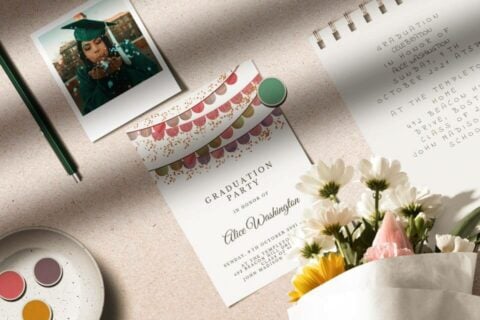
Around 2 million bachelor’s degrees are given out every year, but only a handful of students are chosen to give a graduation speech. It’s a wonderful honor that allows you to make a lasting impression before your classmates start the next chapter of their lives. Everyone will be there to hear you speak, including friends, family, and faculty.
It’s a lot of responsibility, so it’s only natural that you might be feeling a bit nervous and unsure of where to begin. But fear not! There’s a lot you can do to be ready.
Create a stunning party invitation in minutes
Customize and share your invitation with our easy-to-use editor!

Read on for 12 tips to write, prepare and deliver a memorable graduation speech.
Tip #1: read inspirational quotes.
Reading inspirational quotes is a great way to start brainstorming graduation speech ideas. The best quotes can pack a whole speech into only a sentence or two.
Here are a few examples to get the fire of inspiration started:
“The two most important days in your life are the day you are born and the day you find out why.” – Mark Twain
“Life is like riding a bicycle. To keep your balance you must keep moving.” – Albert Einstein
“If you are free, you need to free somebody else. If you have some power, then your job is to empower somebody else.” – Toni Morrison
“Youth is happy because it has the ability to see beauty. Anyone who keeps the ability to see beauty never grows old.” – Franz Kafka
If there are a couple of quotes that truly mean a lot to you, then it’s okay to use them in your speech, but in the long run you should rely mostly on your own words and feelings.
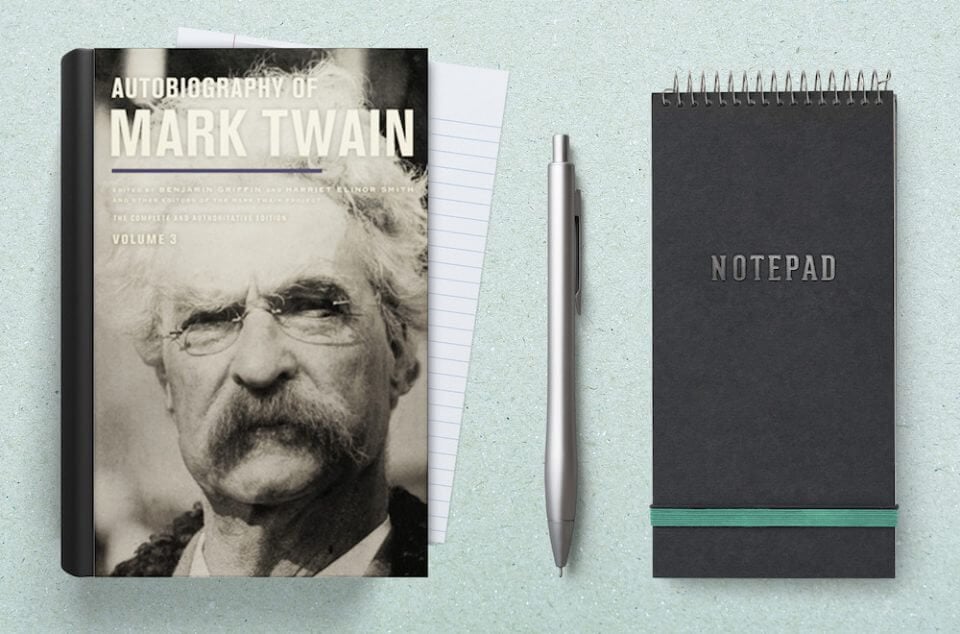
Tip #2: Listen to and Watch Famous Speeches
There is a lot you can learn from listening to and watching famous speeches .
When listening to just the audio of a speech, you can focus on how the speaker uses dramatic pauses and passionate tones to keep their audience’s ears perked up. You’ll also notice that the speaker pronounces words slowly enough so that everything is clear, rather than mumbled.
As you watch a speech, pay attention to how a speaker moves their hands for emphasis instead of gripping the podium for dear life. Facial expressions are also important. A speaker shouldn’t look bored or sleepy, so try smiling and raising your eyebrows from time to time.
Lucky for you, there are plenty of amazing speeches out there to learn from. For example, Martin Luther King Jr.’s “I have a dream” speech about equal rights is one of the most famous speeches of all time. Watch it and find out why.
You can also watch actual graduation speech examples that went viral on the internet because of their truthful messages and sincere delivery.
Tip #3: Reflect on the Past
An important element of a graduation speech is the past, whether distant or recent. Which experiences did you learn from? What has shaped you as a person up until now? Reflect on them.
You can focus on an important moment from your childhood if necessary, but be sure to include notable stories or lessons you learned during your time in school.
This is also a great opportunity to talk about people who inspired and helped you along the way. For example, who was your best teacher and why? What did they teach you?
Almost anyone can give sage advice, but without your personal stories to springboard from, your advice will go into one ear and out the other.
Think of some examples and explore them through writing. Not everything will go into the final version of your speech, but for the time being you should simply search for those stories that reveal shareable pearls of wisdom.
Tip #4: Think About the Future
An equally important aspect of any graduation speech is the future, including its promises and potential pitfalls. Now that you and your classmates are graduating, the future is in the forefront of everyone’s mind.
Think about what exactly you want to do with your life, how you’re going to do it, and why. Of course, you don’t want to focus on your future exclusively. Make sure you zoom out and talk about broad ideas and insights that can be applied to your class or generation.
For example, what common problems, personal or global, will the future hold? What can one do about it? This is a good chance to talk about working together as a community, country, or as one race.
Whether you’re explaining the struggle of depression or the crisis of climate change, it’s crucial to end on a hopeful note. With your speech, you can help guide people forward into the next step of their lives and beyond.
Tip #5: Decide on a Theme or Message
By now, you’ve probably written hundreds of different academic papers. No matter what their topic, though, they all had one thing in common: a thesis. Like any other paper you’ve written for school, your speech should have something similar to a thesis as well.
In other words, your speech will need a theme or message that can keep your audience’s attention focused. The more you ramble, the less likely they’ll pay attention or remember what you say afterward.
A speech can have more than one message, but it’s best to keep it to less than four main messages.
One example is actress Natalie Portman’s graduation speech which focused on fighting against self-doubt and pursuing your passions.
Here are some other ideas for graduation speech themes:
- The benefits of failure
- The importance of imagination
- Embracing the unknown
- Finding your passion
- Facing your fears
- Keeping in touch with your inner child
Tip #6: Start with a Hook, End with a Quote
You only have one chance to grab your audience’s attention, and that’s at the very beginning of your speech. Once you lose them, chances are you won’t get their attention back, so it’s crucial to begin your speech with a hook.
A quote, whether it’s from a book, movie, or elsewhere, is a common way of capturing people’s attention at the beginning of a speech, but there are other ways to hook them too.
Another way is to tell a brief but interesting story that reflects the themes of your speech. Opening with a question or related statistic that you plan on illuminating for the next quarter of an hour or so is yet another way to keep people focused and interested.
Everyone loves a good joke, which is why preparing one is a great way to not only open up your speech, but break the ice too.
While you should start with a hook, you should end with a quote. It can be a quote from someone else, or better yet, it can be a quote from you. Think of a way to summarize your message into a pithy, final statement. If your audience walks away with only the one quote in their heads, they will still receive a valuable insight or piece of advice.
Tip #7: Write Multiple Drafts
The first draft is usually the most daunting because you’re starting with a blank page, but afterward you have something to work with, so it should be less stressful. As you write the first draft, don’t second guess yourself. Rather, let the ideas and words flow as freely as possible.
Once you have your first draft, step away from it for a day or so, then come back to it with a fresh pair of eyes. If you’re like most people, you read in your head, but when editing, it’s a good habit to read sentences out loud to make sure they flow well and sound natural.
While you edit, reword cliché phrases, such as “since the beginning of time” or “the calm before the storm.”
Beware of waffling too. What’s waffling? It’s when you use too many words or sentences to talk about something when it could be phrased more simply and concisely.
As you go through each draft, you’ll want to keep an eye out for any typos. Once you feel really confident in the draft of your speech, send it to a few trusted friends who can provide you with constructive criticism.
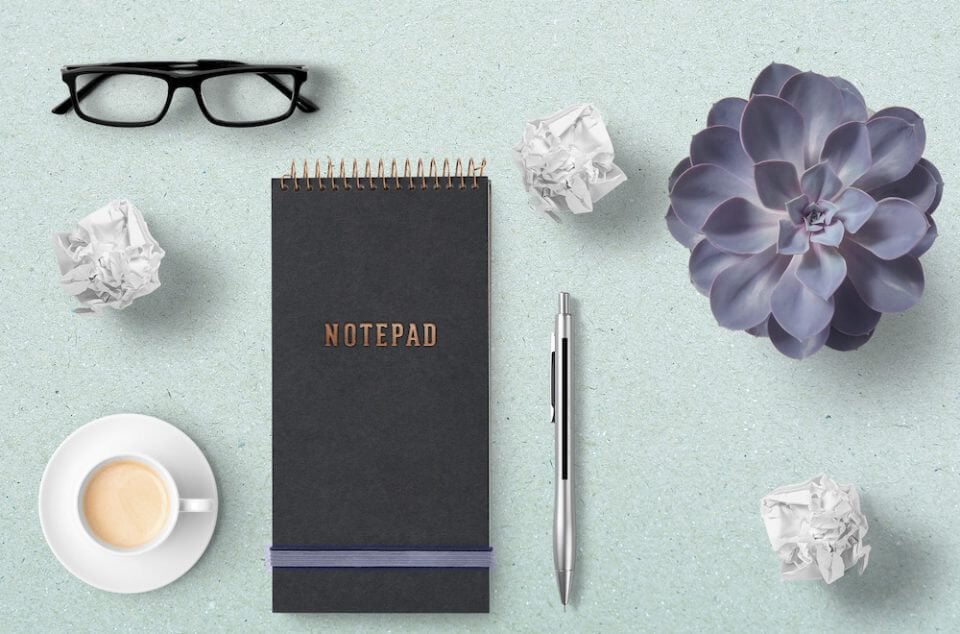
Tip #8: Send Out Graduation Announcements Ahead of Time
You’ll want as many friends and family members there for your big day as possible, so you should send out graduation announcements fairly early. It’s typical to give a notice of at least two weeks, if not more.
Be sure to include the date, location, and time of the event. But why stop there? Most online cards are customizable, so feel free to include a professional picture that shows your confidence and sense of accomplishment.
Encourage your friends and family to make their excitement viral by adding a graduation hashtag to your announcement.
If you plan on having a graduation party, which you most definitely should, make sure you send the invitations out in a timely manner too and be sure to use some of these great graduation party ideas .
For those who are not invited to the ceremony, you can send graduation announcements after the event when you get a chance. Usually within a month is acceptable.
Tip #9: Practice in Front of a Mirror and with a Few Loved Ones
Practicing in front of a mirror allows you to be aware of your facial expressions and body movements. As you speak, emphasize with your voice, face, and arms where it feels necessary and natural.
Having a few loved ones around to practice your speech with has multiple benefits. For one, you can get feedback from them on both your performance and the speech itself. A miniature audience also gives you the chance to get comfortable with making friendly eye contact as you speak. However, it should be relatively brief eye contact, so don’t focus on just one person during your actual speech.
Time yourself as you speak to determine how long it takes to give the whole speech. On average, a graduation speech is about 10-20 minutes long. It should be as concise as possible without sacrificing the content or quality. The right length is something of a balancing act, but with enough practice reading your speech, you’ll develop a feel for what parts may drag on and what parts may need to be expanded.
An additional bonus that comes from repeated practicing is that you’ll be able to memorize more of your speech. After all, it’s better to face the audience as much as possible rather than look down at your notes.
Tip #10: Dress to Feel Confident and Comfortable
It might seem like confidence and comfort are mutually exclusive, but there are certain items you can wear to both look and feel great.
You’ll be doing a lot of standing and walking, so when it comes to women’s clothing, limit heels to 2 inches or wear some fashionable flats. Long skirts are ideal because they don’t restrict your movement and you won’t have to worry about any wardrobe malfunctions. Avoid thin straps or strapless tops by wearing a conservative yet elegant blouse.
Once you have an outfit picked out, test it by wearing it for a day to see how it feels.
For men’s clothing, you can wear dress shoes with gel inserts. There are lots of dress pants with flexible material. It feels like you’re wearing comfy pajamas when in fact you look ready to trade some stocks. There are also button-ups with stretchy material too. It’s best to try these items on in the store to make sure they fit perfectly.
Another option is to choose clothes made from a breathable material, such as cotton.
A neck tie is often notorious for being uncomfortable, but it looks quite snazzy. As a compromise, don’t put the tie on too tightly. If your shirt fits well, the tie should too. On the other hand, clip-on ties are not only comfortable, but also convenient. As long as the clip-on is of high quality, it should look genuine.
If you have an outfit that looks great but doesn’t quite fit right, consider getting it tailored to perfection by a local seamstress.
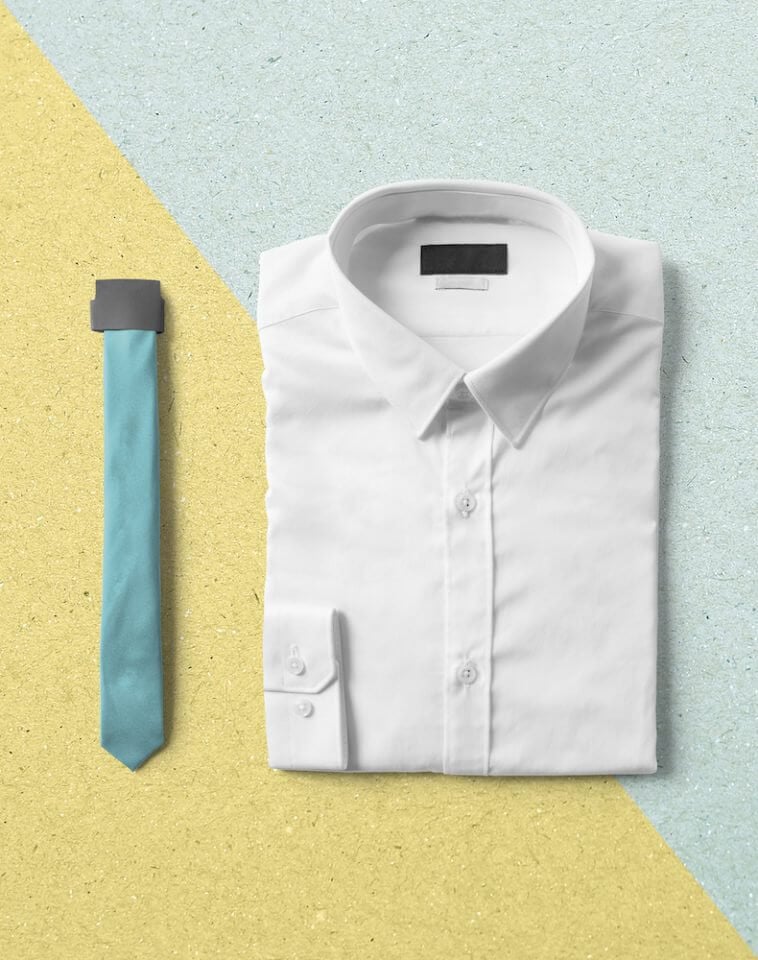
Tip #11: Keep Your Nerves in Check
Say “eleven benevolent elephants” five times fast. Chances are it didn’t come out exactly as you intended.
You’re not a machine, you’re human. You might make a mistake or two during your speech, such as mixing up words or mispronouncing them altogether. That’s totally okay! Don’t dwell on it, just shake it off and start over from where the slip-up occurred.
Take advantage of psychology and feel more confident by striking a power pose beforehand. Go into a bathroom or another private area and stand with your feet wide apart as you lift your arms outward and upward for about a minute.
You should also remember that feeling nervous is perfectly natural. Worrying about being nervous can make you even more nervous. Accept that you’ll feel some degree of anxiety and take a few deep breaths to reduce it as much as possible. Remember that pauses feel a lot longer in your mind, so most people won’t notice you taking a moment to catch your breath during your speech.
Tip #12: Be Yourself
Even though researching speeches comes with a lot of benefits, you should remember that everyone is an individual with their own habits and style. It’s normal to feel pressured when you have to prepare such an important speech. When you look for inspiration, you may be tempted to try and mimic these idols.
While it’s important to learn from such great speakers, you should only take from them the skills that work for you and adapt them to your own habits and style.
You weren’t chosen to give a graduation speech because you’re Abraham Lincoln or Malala Yousafzai. You were chosen for the simple reason that you’re you. If you’re known for being funny, then go ahead and tell a couple of jokes. If you’re the sentimental type, feel free to let loose a few tears.
You’re much more likely to give a memorable speech if you stay true to yourself and your beliefs.
Are You Ready to Send Out Your Graduation Announcements?
Now that you know how to go about giving a memorable graduation speech, you should be ready to send out your announcements and grad party invites .
For the price of nothing, Greetings Island has an amazing variety of artistic announcements and invitations to let everyone know about your upcoming big day. They are easily customizable so you include all your information in an awesome presentation that fits your tastes. The perfect design is a mere click away!
After the festivities, you can also send lovely graduation thank you cards to show your gratitude to your friends and family.
Once you’ve customized your announcements, you can easily print them at home or at a professional print shop. Keeping things virtual? We have additional options, such as sending them through email with RSVP services or downloading them as high-res images that you can share on social media networks.

Related Posts

22 Creative Preschool Graduation Themes to Celebrate Your Little Ones

How To Write Graduation Announcements: 30 Wording Ideas

Proven Family Reunion Planning Ideas for a Dazzling Event

How to Write and Deliver a Memorable Graduation Speech: Tips, Examples, and Techniques
- The Speaker Lab
- March 7, 2024
Table of Contents
The goal of any graduation speech is to find words that capture the essence of years spent learning and growing. Today, we’ll guide you through that process and help you craft a memorable graduation speech . You’ll learn to weave gratitude with shared experiences, and balance humor with wisdom. We’ll even help you find quotes that strike a chord and deliver them in a way that resonates.
But that’s not all! Dive into proven strategies for public speaking, managing stage fright, and drawing inspiration from iconic commencement speeches. Discover how personal growth stories add depth to your message and explore themes that leave a lasting impact on your peers as they step forward into new beginnings.
Crafting Your Graduation Speech: A Step-by-Step Guide
When it comes to marking the end of your high school or university journey, a graduation speech can capture the essence of this pivotal moment. But how do you start such an important address?
Opening with Impact
The first words of your graduation speech are crucial. They set the stage for what’s to come and grab your audience’s attention. Think about starting strong by sharing a personal anecdote that ties into the broader experience of your class or drawing from Steve Jobs’ Stanford University commencement speech , where he began with, “Today I want to tell you three stories from my life.” This technique instantly piques interest because it promises narratives that have shaped who you are.
An impactful opening also acknowledges shared experiences. Perhaps you could reflect on how moments in classrooms turned strangers into lifelong friends. Or for university commencements, consider touching upon those late-night study sessions that tested perseverance but ultimately led to academic achievements worth celebrating today.
Building the Body of Your Graduation Speech
In crafting the body content, intertwine lessons learned throughout high school years or during university courses with aspirations for what lies ahead. For instance, share how overcoming obstacles like balancing extracurricular activities and academics taught valuable time management skills.
To add depth, incorporate quotes from luminaries like Oprah Winfrey or draw parallels between classroom learnings and real-world applications. Dive deeper by discussing milestones achieved together as a graduating class and recognizing the hard work everyone put in to make it to this monumental occasion.
Concluding with Inspiration
Your conclusion should leave fellow graduates feeling inspired while helping them celebrate high school memories one last time—or honor those unforgettable college years if addressing higher education grads.
Closing remarks could include heartfelt gratitude towards teachers’ support and parental guidance. You might even crack a joke or two. It’s these personalized touches paired with universal truths that resonate most deeply as students step forward into new chapters post-graduation.
Find Out Exactly How Much You Could Make As a Paid Speaker
Use The Official Speaker Fee Calculator to tell you what you should charge for your first (or next) speaking gig — virtual or in-person!
Delivery Techniques for Confident Speaking
Standing in front of a crowd can turn even the most composed student into a bundle of nerves. But fear not, with some smart strategies, you’ll be able to channel your inner orator and deliver your graduation speech with confidence.
Practicing Your Graduation Speech
Becoming familiar with every word of your speech is key. Rehearse it out loud until the words feel like second nature. This practice does more than just help you remember what comes next; it lets you find the natural rhythm and pace of your delivery. Consider recording yourself to catch any quirks or stumbling blocks—you might be surprised at how much this helps refine your presentation.
A trick often overlooked is practicing in different environments. If possible, stand on the actual stage where you will deliver your commencement address. Familiarity breeds comfort, making that once daunting podium seem like an old friend when graduation day arrives.
Overcoming Nervousness and Stage Fright
Nervousness is normal but doesn’t let it dictate your performance. Before stepping up to speak, take deep breaths to steady yourself—a calm body encourages a calm mind. An effective method for easing anxiety is visualization. Imagine delivering each line perfectly and receiving an enthusiastic response from listeners—envisioning success can make it so.
Maintaining Eye Contact
The power of eye contact cannot be overstated. It connects speaker and listener on a personal level that amplifies engagement significantly. Scan across different sections of the audience periodically without lingering too long on any one individual.
Incorporate these techniques diligently when preparing for the big day. In doing so, they become part of muscle memory and help build confidence. With confidence and plenty of practice on your side, your graduation speech is sure to conclude to applause leaving you to celebrate yet another milestone achieved.
Analyzing Renowned Graduation Speeches for Inspiration
When crafting a commencement speech , it’s often helpful to look at the giants whose words have echoed through auditoriums and across campuses. Steve Jobs’ Stanford University Commencement Speech is a classic example of weaving life lessons into an address that connects deeply with graduates. Similarly, Oprah Winfrey’s Harvard University Commencement Address showed how stumbling blocks can become stepping stones if we learn from them.
Steve Jobs’ Storytelling Mastery
Jobs had a knack for turning personal anecdotes into universal truths. In his Stanford address, he shared three stories from his own life without sounding self-indulgent. These stories worked because each one carried a broader message relevant to every graduate: finding what you love, dealing with loss, and facing death head-on. Jobs famously urged students to “stay hungry, stay foolish,” encouraging them not just to pursue success but remain curious about life despite challenges. This advice is especially poignant for today’s graduating class.
Like Jobs, you too can craft narratives around moments that speak volumes about perseverance and passion.
Oprah’s Unflinching Honesty
Much like her television persona suggests, Oprah did not shy away from discussing her setbacks in front of Harvard’s graduating class. Instead, she confidently laid bare the challenges faced by anyone who dares greatly because failure is part of achieving greatness. As she reminded students, “It doesn’t matter how far you might rise… At some point you are bound to stumble.”
In doing so she forged an instant connection with listeners grappling with their fears about what the future holds post-graduation. It was a powerful reminder that even icons like Oprah are not immune to trials but emerge stronger through them.
The power behind these speeches lies not just in their content but also in their delivery. These speakers mastered the art of speaking confidently before crowds, maintaining eye contact, and conveying authenticity—techniques any speaker should aspire to replicate on graduation day.
Themes and Messages That Resonate with Graduates
Facing a sea of caps and gowns, the right words can turn a graduation ceremony from mundane to memorable. When crafting your commencement speech, focusing on themes like overcoming obstacles and perseverance connects deeply with graduates who have hurdled high school or college challenges.
Overcoming Obstacles
Talking about stumbling blocks is not just relatable; it’s inspirational. Think Steve Jobs at Stanford University or Oprah Winfrey at Harvard—both shared personal tales of setbacks turned into comebacks. Beyond simply telling their stories, they showed how those hurdles were stepping stones to success.
Weave your narrative around the potholes you’ve navigated during your high school years. This doesn’t mean airing every bit of dirty laundry, just highlighting that one significant moment where everything seemed against you yet failed to defeat you.
The Power of Perseverance
Perseverance is more than sticking to something—it’s pushing forward when every fiber wants to quit. It resonates because everyone, including your fellow graduates, has felt that urge to give up but chose to persevere instead.
Incorporate this theme by using vivid examples that mirror collective experiences—the all-nighters before exams or balancing sports stars ambitions with academics—to illustrate perseverance isn’t just an idea but lived reality for many students.
Free Download: 6 Proven Steps to Book More Paid Speaking Gigs in 2024
Download our 18-page guide and start booking more paid speaking gigs today!
Life Lessons Shared During Graduation Speeches
In addition to sharing content that fellow graduates will find relatable and inspirational, you should also consider sharing life lessons with your audience. Whether young or old, everyone has a unique perspective on life and sharing your wisdom can steer graduates toward a fulfilling path.
The Power of Kindness
Making a positive impact doesn’t require grand gestures; sometimes it’s found in small acts of kindness or an innovative idea that simplifies lives. This message sticks because everyone wants their work to mean something—to know they’ve left footprints on society’s vast canvas.
True Grit and Tenacity
Embracing failure and resilience is another powerful theme echoed by commencement speakers across podiums. Let’s face it; not all endeavors lead straight to success. But as Oprah Winfrey once said during her Harvard University commencement address, “It doesn’t matter how far you might rise… At some point, you are bound to stumble.” Her words remind us: How we pick ourselves up matters more than how we fall.
Making a Positive Impact
A graduating class stands poised on tomorrow’s threshold ready to mold history—and speeches should fuel this transformative fire within them. Memorable graduation speeches show individuals that ovation-worthy achievements are possible if you believe your actions count.
As you prepare your graduation speech, consider including one of these life lessons or one of your own. Don’t be afraid to share your hard-won insights to your fellow graduates—you just might inspire them to make history.
Celebrating Achievements and Acknowledging Contributions
Graduation is not just a ceremony. It’s a tribute to the academic achievements and extracurricular activities that have shaped students into who they are. The acknowledgment of teacher support and parental guidance also plays a pivotal role in these speeches, as they’re the scaffolding upon which student successes are built.
Academic Achievements, Extracurricular Activities
Acknowledging academic prowess goes beyond GPA scores or honor societies; it’s about highlighting unique intellectual journeys. Similarly, shining a light on extracurricular triumphs—be it sports stars setting records or artists winning competitions—adds depth to your speech. Remembering these moments isn’t merely recounting victories but celebrating the relentless spirit of your fellow graduates.
Diving deeper into personal anecdotes helps you connect with peers by reminding them of their growth through challenges faced together—from late-night study sessions to championship games. It’s these stories that make graduation memories stick with classmates long after commencement ends.
Teacher Support, Parental Guidance
The unsung heroes behind every graduate deserve their moment in your address too. Teachers’ dedication can turn classrooms into launch pads for dreams, while parents’ unwavering belief often fuels aspirations during tumultuous times like the pandemic.
In weaving tales of mentorship from teachers or wisdom imparted by parents, you remind everyone that success is rarely a solo act—it’s supported by many hands and hearts along the way. Celebrate this collective effort because each person has contributed uniquely to shaping graduating classes across America, including yours.
Common Issues in Writing and Delivering Graduation Speeches
Staring at a blank page as the clock ticks down to graduation day can rattle even the most seasoned speech writers. Overcoming writer’s block is about finding your message stick—the core idea that you want to leave with your peers. Remember, this isn’t just any talk; it’s one that marks a significant transition for both you and your audience.
Overcoming Writer’s Block
Finding yourself stumped on how to write a speech ? Don’t sweat it. Start by jotting down memories from school years or powerful life lessons that resonate. Think of Steve Jobs’ Stanford University commencement speech where he shared personal stories, which became an inspirational backbone for many other speeches.
If inspiration doesn’t strike immediately, step away from the computer. Take a walk and reflect on high school experiences or browse through commencement speeches archives—like Lin-Manuel Miranda’s address at the University of Pennsylvania. They might spark ideas you hadn’t considered yet.
Navigating Technical Troubles
A great speech can stumble over technical hiccups. To avoid glitches, check all equipment beforehand—a simple but crucial task often overlooked due to nerves or excitement about graduating class celebrations.
Prior rehearsals will also let you handle these issues like a pro should they pop up during delivery. Make sure any videos or slides complement rather than overshadow what you’re saying. After all, graduates aren’t there for bells and whistles—they’re there for meaningful words.
Handling Stage Fright
Your knees may shake thinking delivering in front of proud parents and peers—it’s no small feat, after all. Before you step on stage, visual your success until it feels more real and attainable.
And don’t forget to watch your body language. During your speech, maintain eye contact—not stare-downs—to connect genuinely with fellow students. And if anxiety creeps up despite practice sessions? Take deep breaths to steady yourself and keep going. You’ve handled high school—you can handle this.
FAQs on Writing and Delivering a Graduation Speech
What do i say in my graduation speech.
Share heartfelt stories, acknowledge support from others, and inspire your classmates to chase their dreams boldly.
How do you write a 3 minute graduation speech?
Keep it tight: hit the high notes with gratitude, shared memories, a dash of humor, and wrap up with punchy inspiration.
How do I start a graduation speech?
Kick off with thanks. Give props to family and mentors. Set the stage for reflecting on past adventures together.
What is the most important message of a graduation speech?
The core should spark hope—urge peers to leap into tomorrow equipped with lessons learned during these formative years.
Master your moment with a graduation speech that turns heads and warms hearts. Remember the power of gratitude and connect with your audience through stories, those shared adventures that bind you to your classmates. Don’t be afraid to add a few jokes and quotes to your speech either, as well as personal growth stories to inspire.
When you hit the stage, stand tall, make eye contact, and speak from your heart—the podium’s yours. If butterflies invade, breathe deep and know everyone’s rooting for you. Writer’s block didn’t stop you and neither will this.
Your graduation speech is not just words—it’s a battle cry for your graduating class as you prepare to conquer what lies ahead!
- Last Updated: March 5, 2024

Explore Related Resources
Learn How You Could Get Your First (Or Next) Paid Speaking Gig In 90 Days or Less
We receive thousands of applications every day, but we only work with the top 5% of speakers .
Book a call with our team to get started — you’ll learn why the vast majority of our students get a paid speaking gig within 90 days of finishing our program .
If you’re ready to control your schedule, grow your income, and make an impact in the world – it’s time to take the first step. Book a FREE consulting call and let’s get you Booked and Paid to Speak ® .
About The Speaker Lab
We teach speakers how to consistently get booked and paid to speak. Since 2015, we’ve helped thousands of speakers find clarity, confidence, and a clear path to make an impact.
Get Started
Let's connect.
Copyright ©2023 The Speaker Lab. All rights reserved.
- Grades 6-12
- School Leaders
NEW: Classroom Clean-Up/Set-Up Email Course! 🧽
18 Examples of End-of-Year Letters to Students and Their Families (Plus Free Templates)
Tips and examples to craft letters for your students.
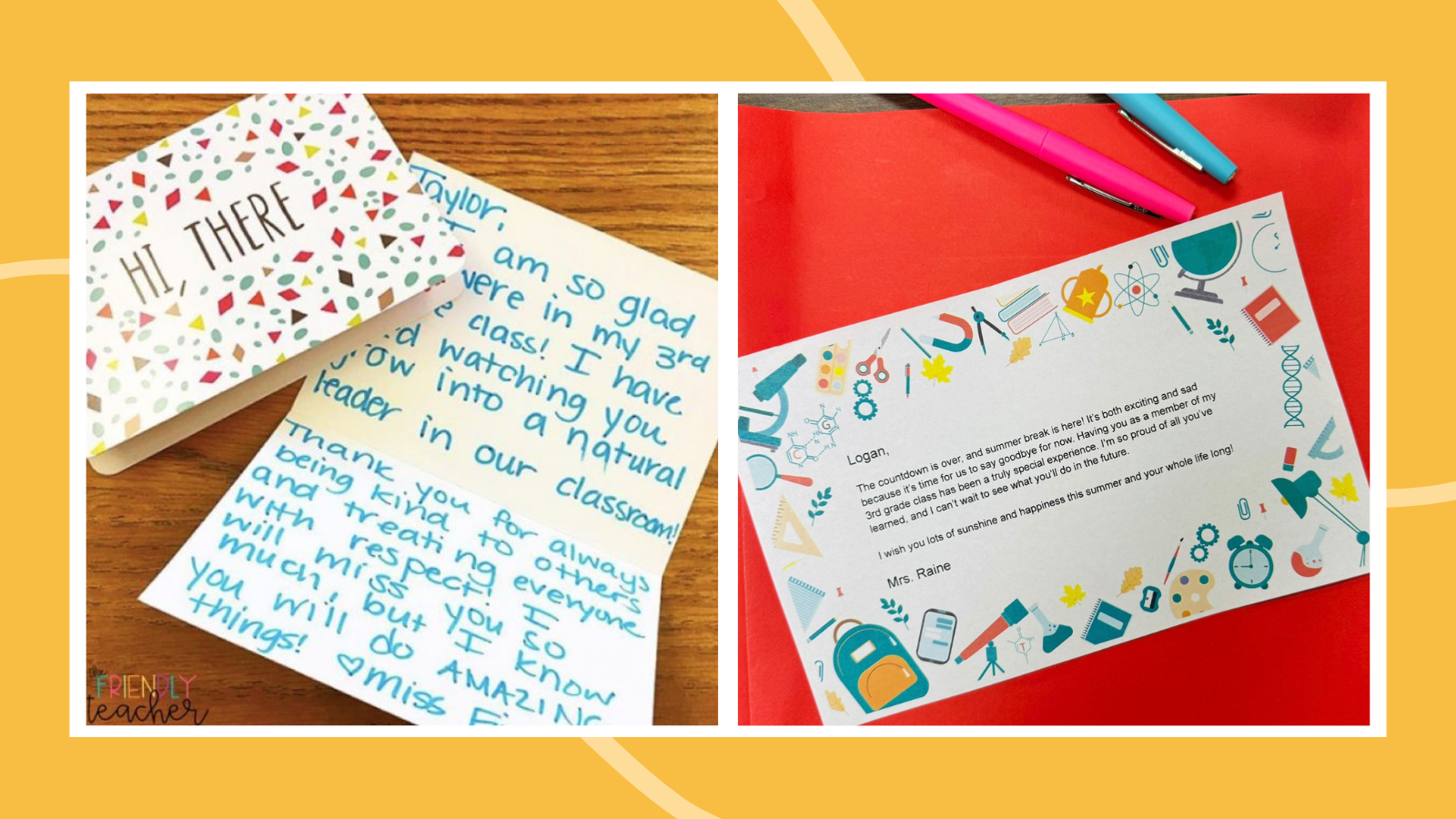
Saying goodbye to students can be so hard. After spending a whole year working together, it’s impossible to imagine our classrooms without them! One of the best ways to show them how much they mean to you is to write end-of-year letters to students. Take a look at some terrific examples from other teachers, and learn how to write your own. Plus be sure to fill out the form on this landing page to get a bundle of three printable end-of-year letters you can customize for your students.
How To Write End-of-Year Student Letters
Keep it short.
We make a lot of memories with our kids, but trying to create a highlight reel for everyone would be tough. It’s better to keep your end-of-year letters to students short and sweet. Even if it’s brief, it can be heartfelt.
Personalize
Even if you use a template, there are ways to customize your letters. Of course, you’ll want to address your notes to each student by name. Along with your signature at the bottom, though, you can mention one special thing you’ll remember about them so that it feels more personal.
Use a template
A template makes it easy to quickly customize letters for each of your students. Fill out the form on this page to get our free downloadable end-of-year letter templates!
End-of-Year Letter Examples and Ideas
Take a look at what other teachers have written to find more ideas for your own end-of-year letters to students and families.
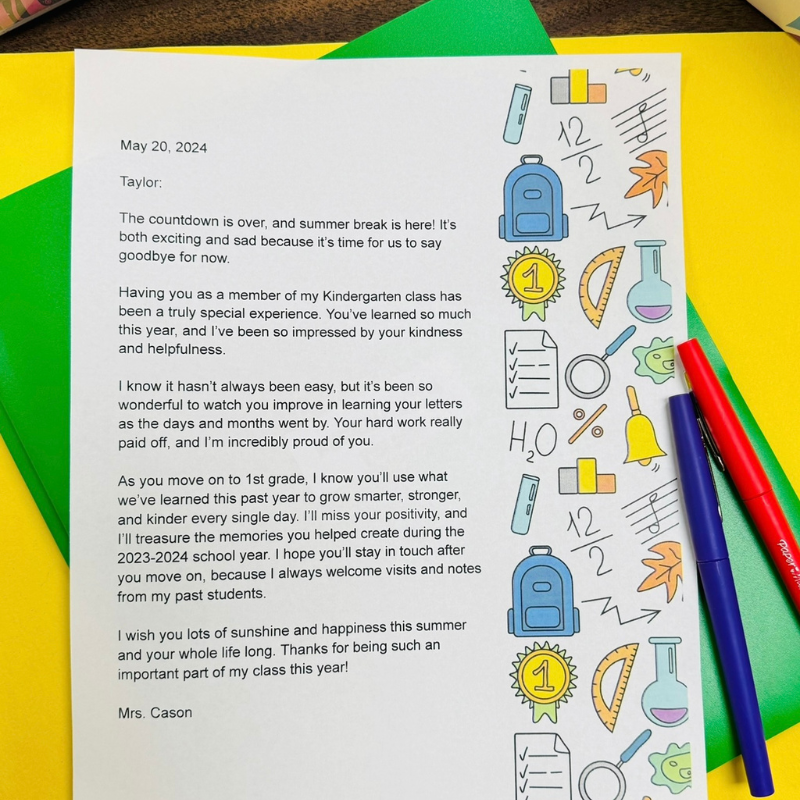
FEATURED PICK
1. Personalized Heartfelt Letter
Use our free Google Docs template to easily customize letters for each of your students. You can personalize as much or as little as you’d like. Just fill out the form on this landing page to grab it along with two others featured below.
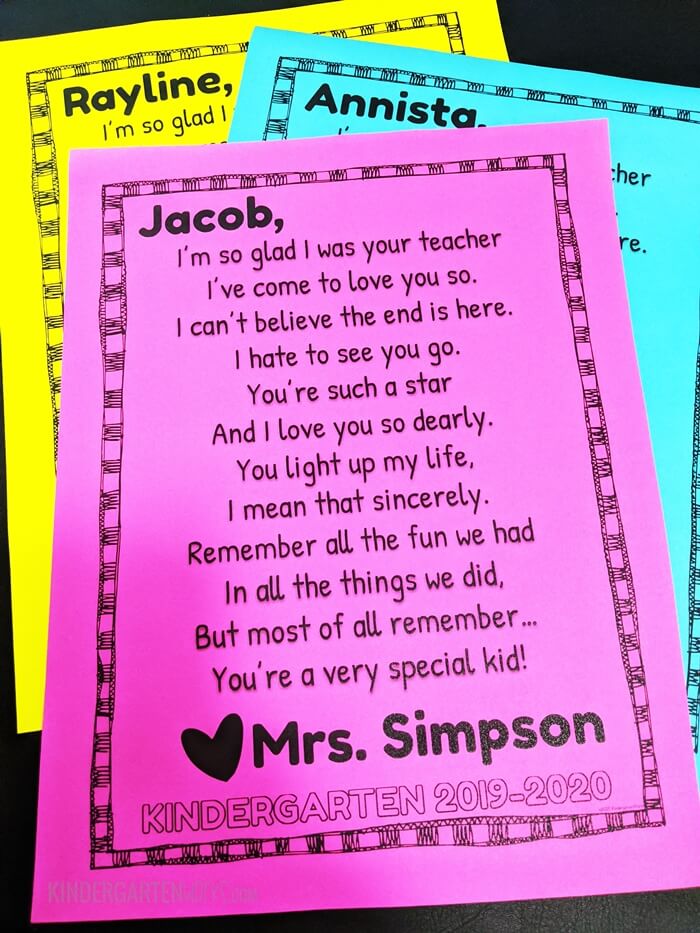
2. Goodbye Poem
Sometimes a poem can capture our feelings better than any letter ever could. This sweet letter is perfect for letting your students know how much they mean to you, while also reinforcing language skills. It’s a win-win!
Get it: Goodbye Letter
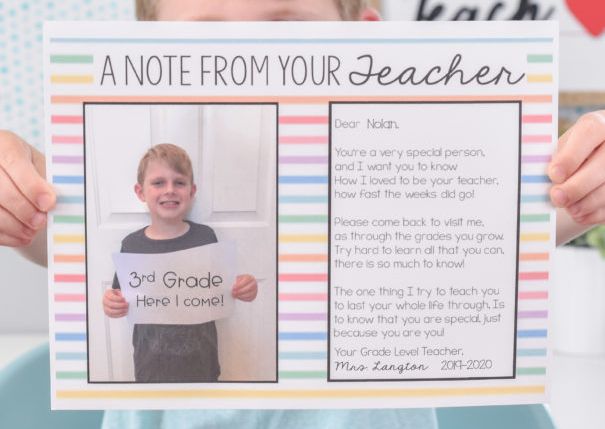
3. Letter With Picture
Including a photo of your student is an easy way to personalize your letter, plus it gives families a cute keepsake they’ll love to pull out and share years from now.
Get it: Easy End of Year Student Letter
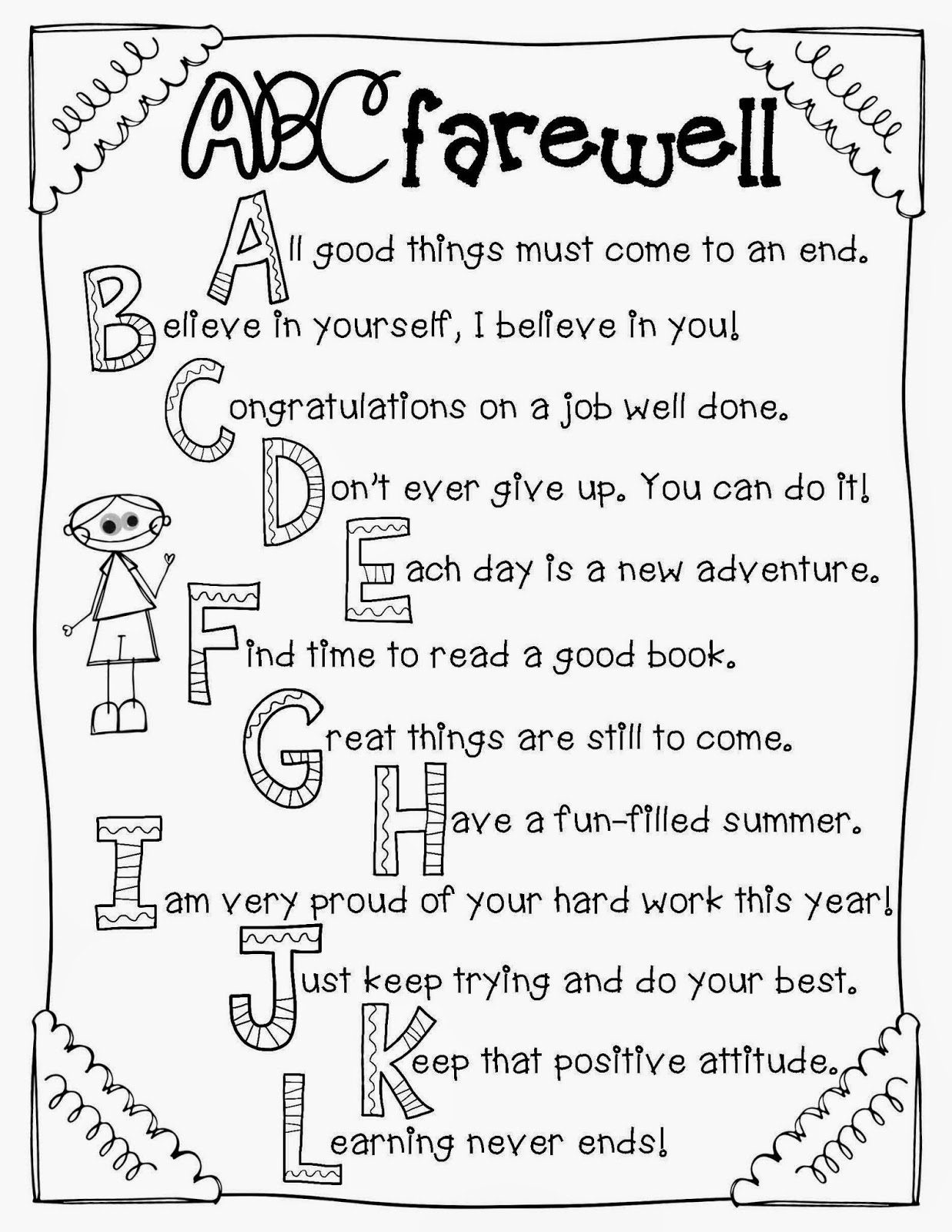
4. ABC Farewell
This is an incredibly clever idea, and perfect for the early elementary grades. You could even personalize this by including the student’s name for the letter it starts with!
Get it: Clip Art and ABC Farewell
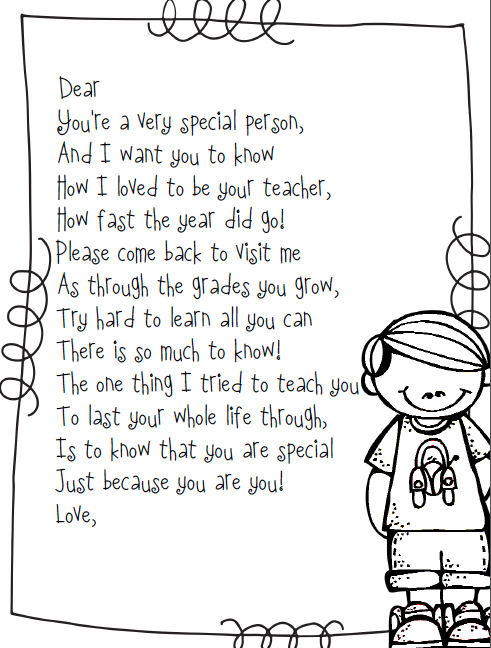
5. Poem With Colorable Picture
Pass these out on the last day of school and let kids color their pictures. The final result is a little bit of you and a little bit of them, all in one!
Get it: End of Year Poem
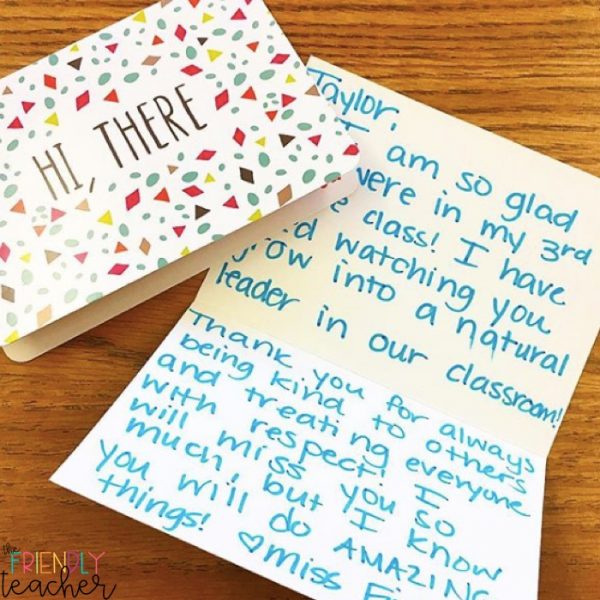
6. Personal Card
Choose some note cards you love and spend a few hours writing personal messages. This takes a little more time, but you only need a few short sentences to make students and their families feel really special.
Get it: Sending Letters Home
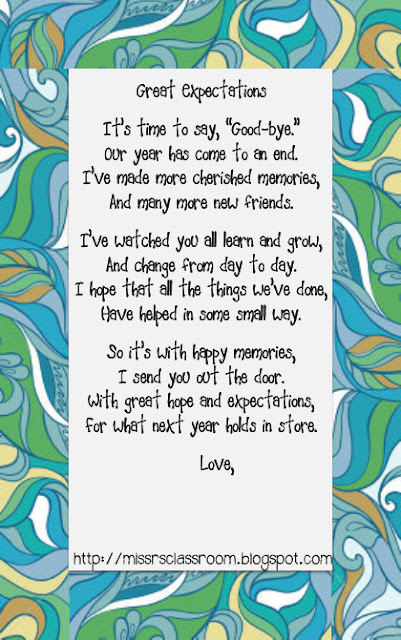
7. Great Expectations Poem
Here’s another sweet poem, with wonderful wishes for a student’s future. Jot a personal memory on the back to make it even more special.
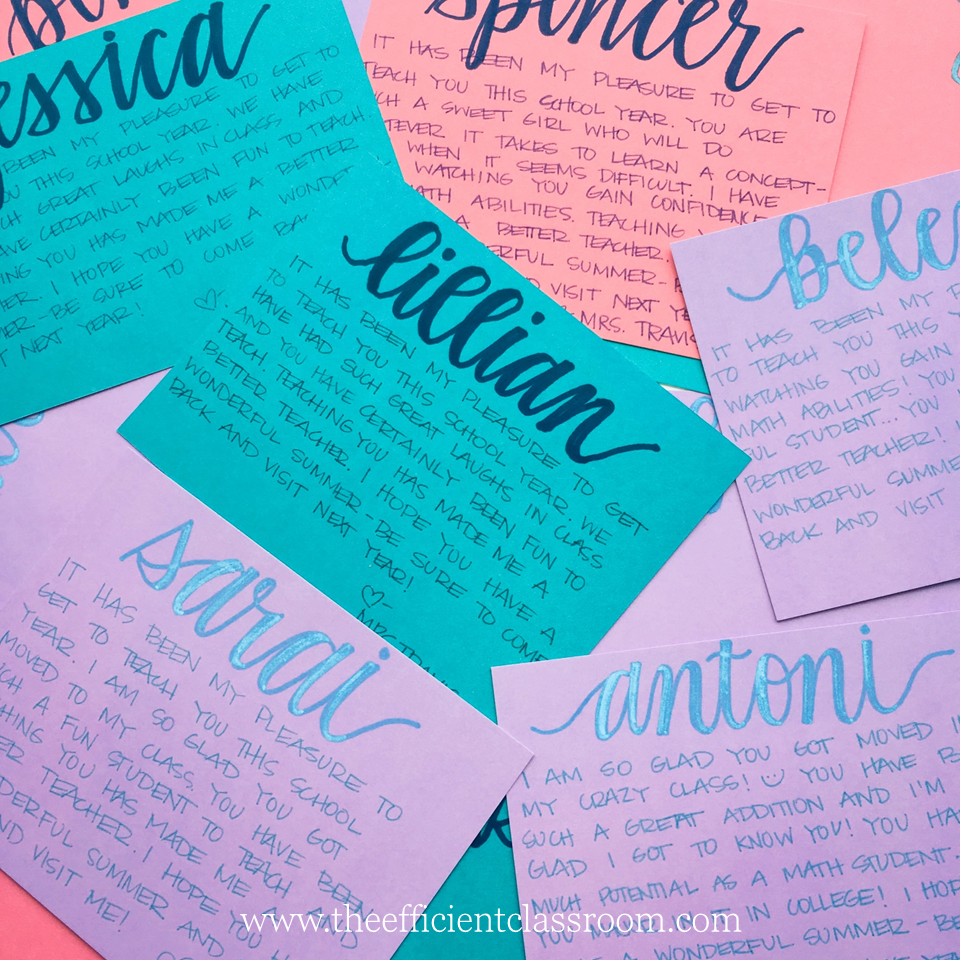
8. Handwritten Note
You can use the same message over and over again, but handwriting it out makes it feel more personal. We love that these letters feature the students’ names in beautiful calligraphy at the top too.
Get it: Handwritten Letters
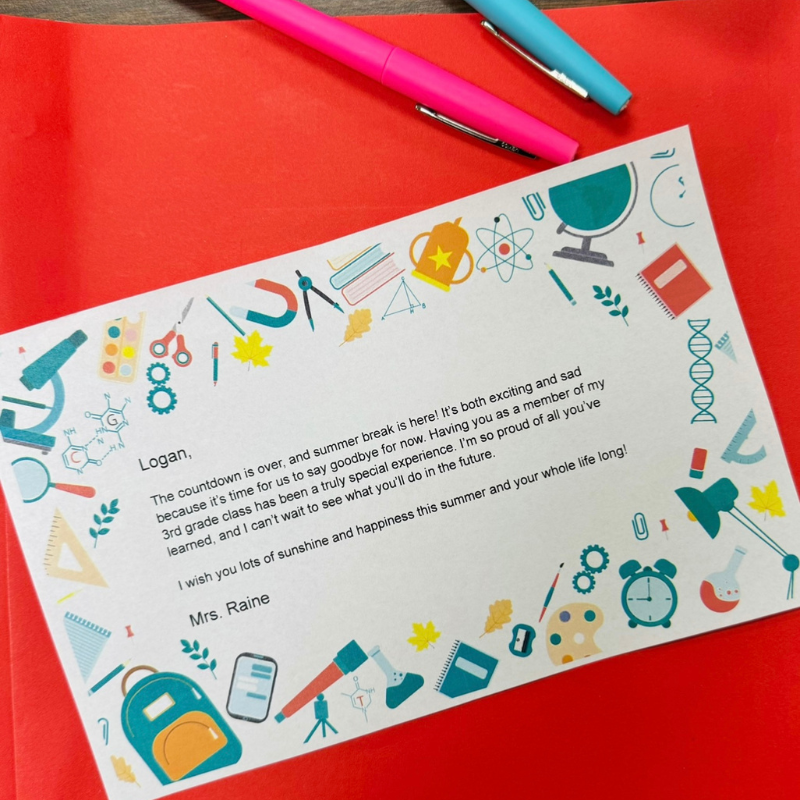
9. A Note for Older Kids
This end-of-year letter template has a design that works well for older students. Just fill out the form on this page to grab your free customizable Google Docs template.
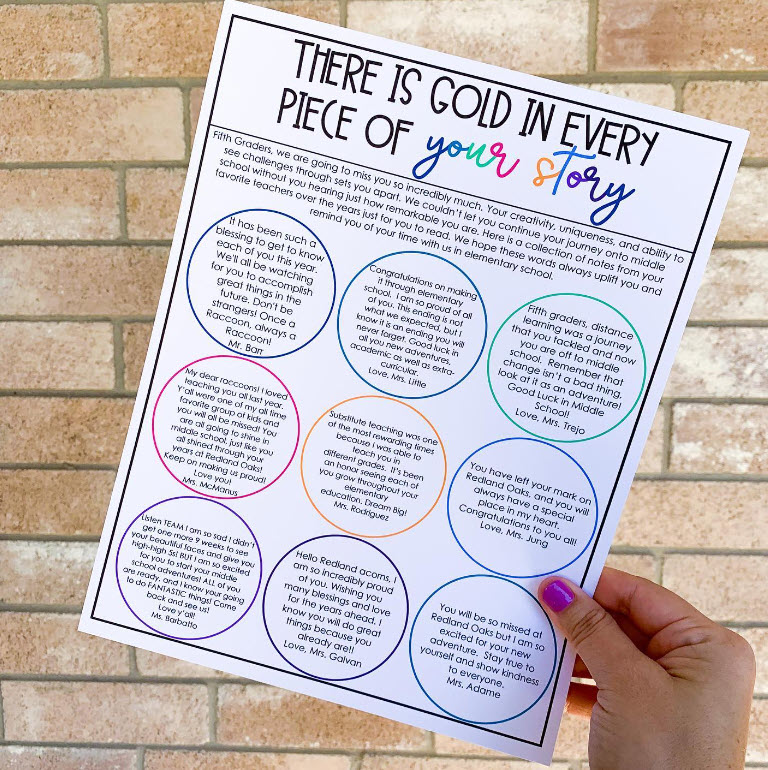
10. Gold in Every Piece of Your Story
This collaborative letter is such a cool idea! Gather quotes, stories, and words of wisdom from various people who’ve interacted with your students over the last year, and gather them together into one sweet document they’ll cherish.
Get it: There Is Gold Letter
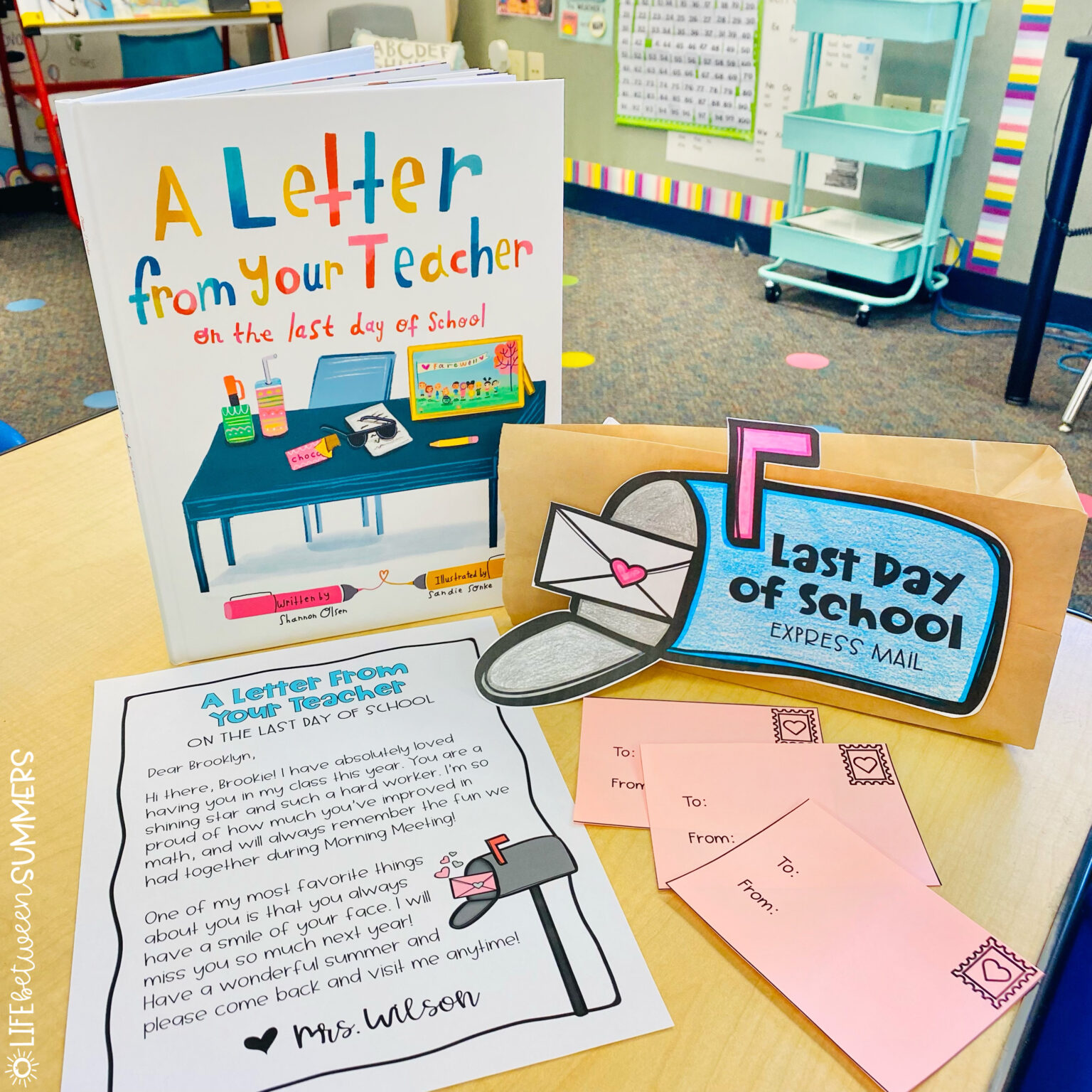
11. Mailbox Activity
Pair your end-of-year letters to students with this cute activity. Each student turns a paper bag into their own mailbox. Then, they write letters to each other to slip into the boxes, along with your own special deliveries.
Get it: Mailbox Activity
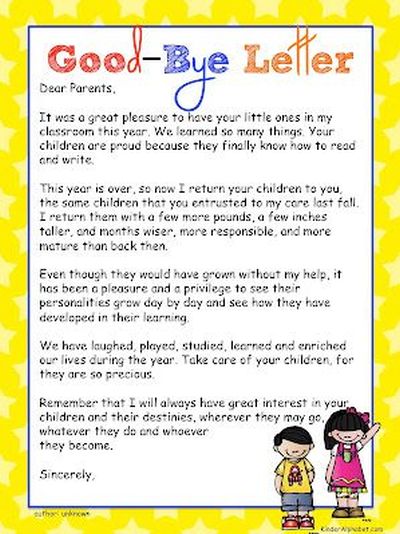
12. Family Letter
Parents and guardians will appreciate a letter at the end of the year too. Use it to sum up some of the great things that happened, and invite them to keep in touch in the future.
Get it: Good-Bye Letter
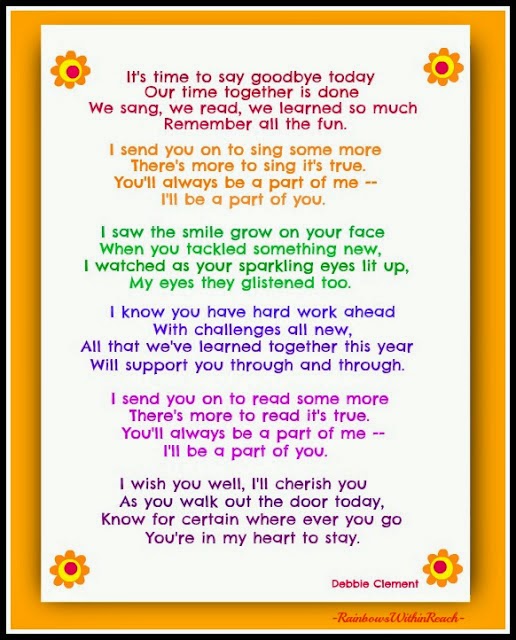
13. It’s Time To Say Goodbye Poem
Poems are popular for end-of-year letters, and this one by Debbie Clement is truly sweet. It’s perfect for preschool and early elementary, especially when you add your own short note to personalize it.
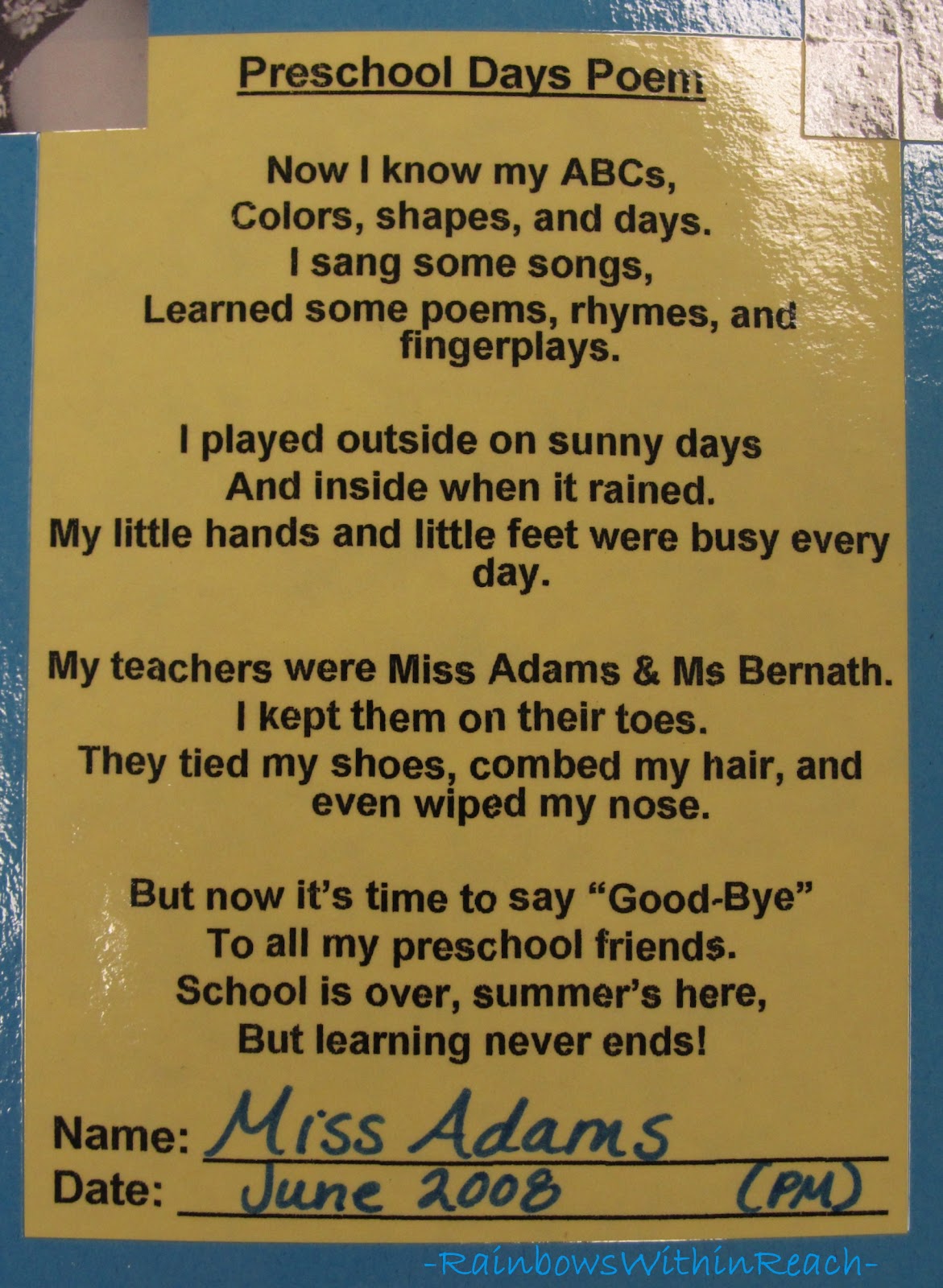
14. Preschool Days
Here’s another clever rhyme for young students, this one specific to preschool activities and learning. Personalize it with teacher names, and parents can tuck this into their child’s memory book as a keepsake.
Get it: Preschool Days Poem
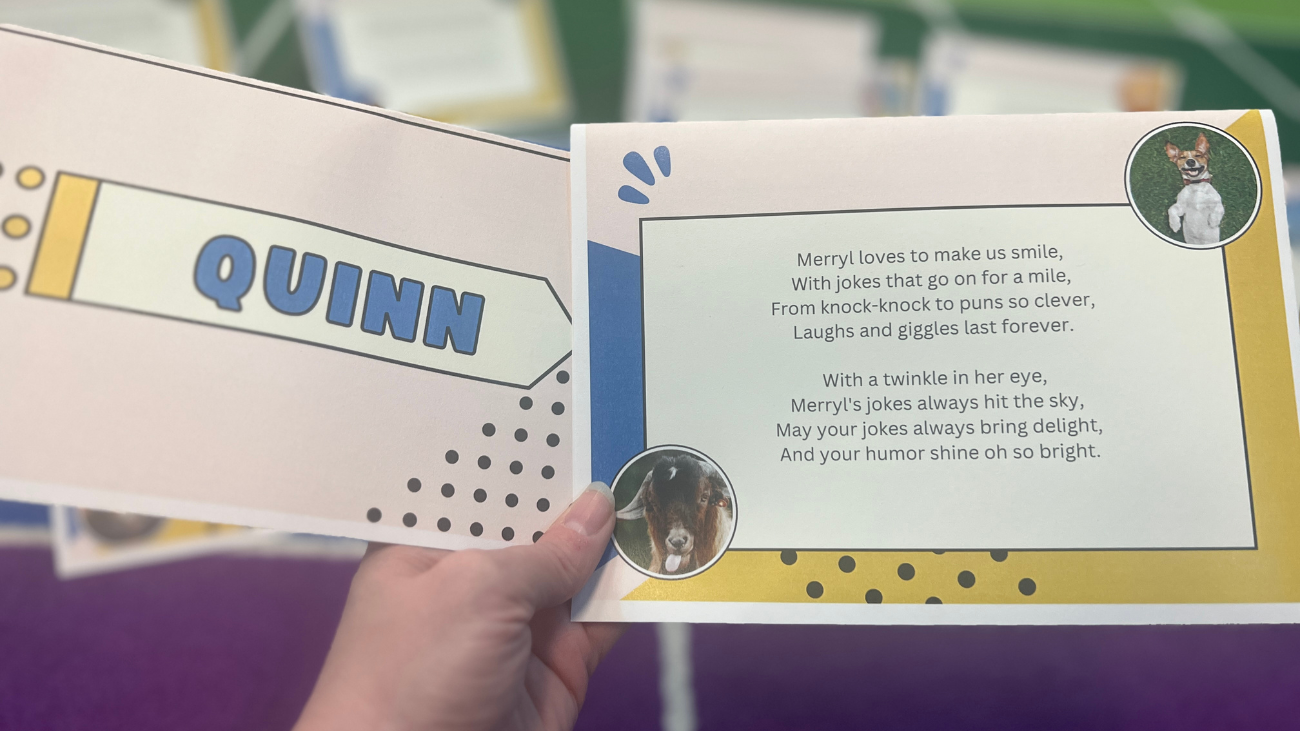
15. AI Customized Letters or Poems
This is one of the ways ChatGPT can be a real time-saver for teachers! With just a few simple prompts, the program can write individualized letters for your students. One teacher even used it to write custom poems!
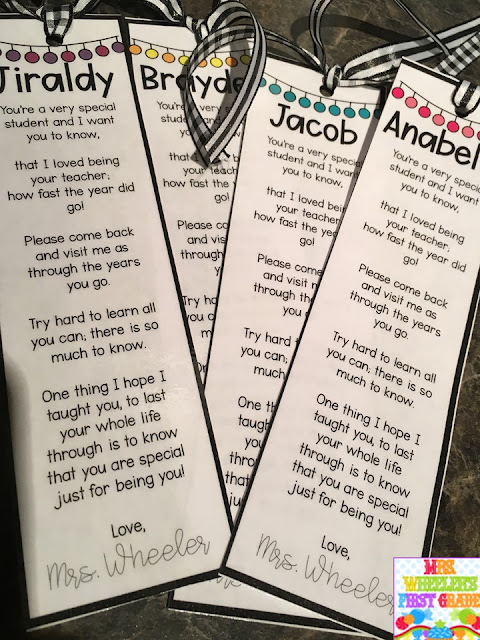
16. End-of-Year Bookmarks
When you turn your end-of-year letters into bookmarks, students can keep them close at hand for years to come.
Get it: Bookmarks
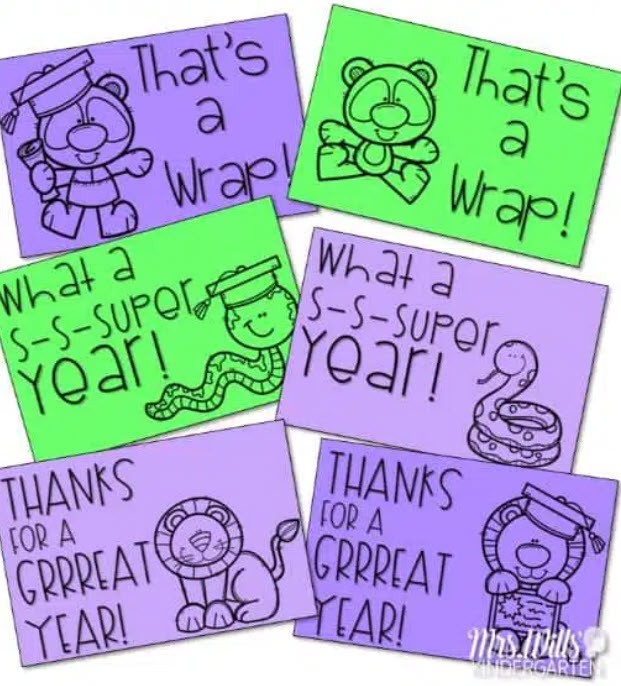
17. Free Printable Notes
Print simple notes on colorful paper, then flip them over and write a line or two on the back that’s customized for your student. Simple and so thoughtful!
Get it: Printable Notes
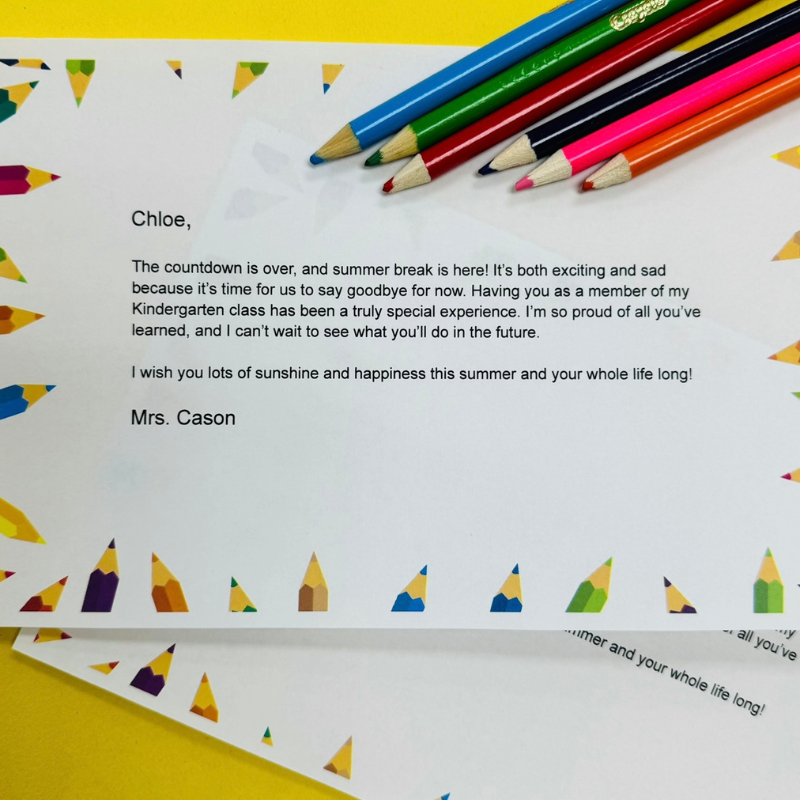
18. Short and Sweet Note
This end-of-year letter template’s design is perfect for a short and sweet message to elementary students. Get the free Google Doc template for this letter and two others when you fill out the form on this landing page.
Be sure to fill out the form on this page to get your free End-of-Year Student Letter templates!
Plus, 50 Free Printable End-of-Year Awards for Students .
Want more articles like this be sure to subscribe to our newsletters .
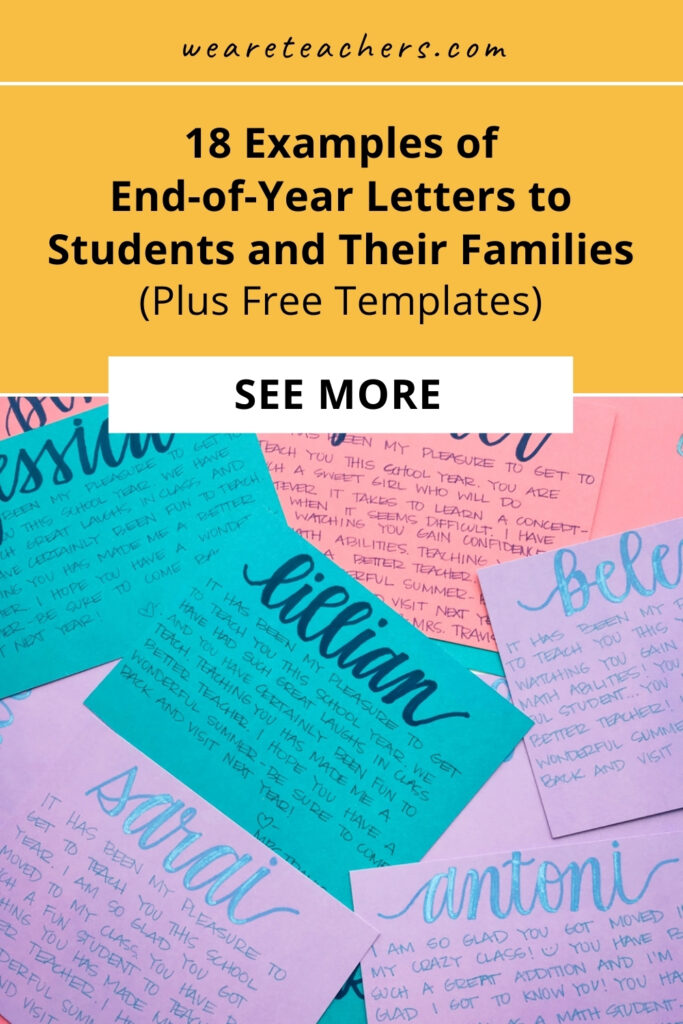
You Might Also Like
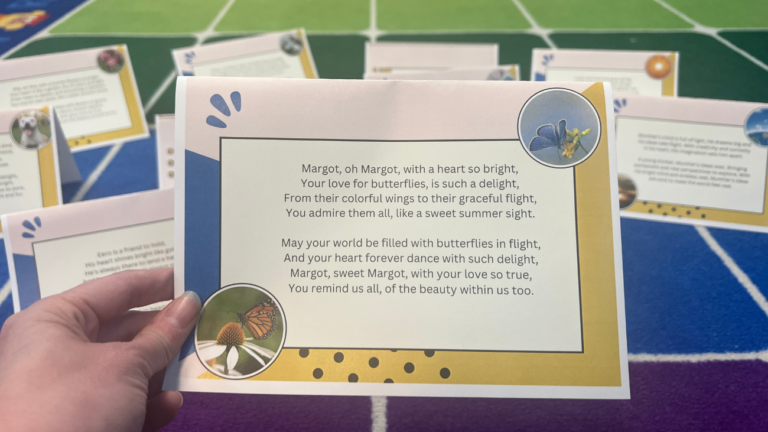
This Teacher Asked ChatGPT to Write a Personalized End-of-Year Poem for Each of His Students, and the Results Are Pretty Great
You can have personalized poems in minutes. Continue Reading
Copyright © 2024. All rights reserved. 5335 Gate Parkway, Jacksonville, FL 32256
Note-Taking
- Categories: Engaging with Courses

Think about how you take notes during class. Do you use a specific system? Do you feel that system is working for you? What could be improved? How might taking notes during a lecture, section, or seminar be different online versus in the classroom?
Adjust how you take notes during synchronous vs. asynchronous learning (slightly) .
First, let’s distinguish between synchronous and asynchronous instruction. Synchronous classes are held live with the instructor and students together, and asynchronous classes are recorded by the professor for students to view at their convenience. Sometimes asynchronous instruction may include a recording of a live Zoom session with the instructor and students.
With this distinction in mind, here are some tips on how to take notes during both types of instruction:
During a live class, jot down notes as the lecture or discussion progresses. Try to do so during pauses in the lecture or discussion so that you don’t miss the next piece of information. This form of note-taking is something that you’re probably already used to doing in the classroom.
Recorded lectures and class discussions can be paused, but we suggest you try to watch videos all the way through the first time without stopping them. This method allows you to see the whole arc of the material as you take notes and will prevent you from being tempted to write down every word the instructor says (which is typically less useful for studying than notes where you’ve processed the instructor’s words as you listened). You can write down the time marker if you think you’ll need to return to fill in a gap, which you may find is unnecessary once you’ve seen the video the whole way through. We also encourage you to watch videos at their regular speed, as if you were sitting in a synchronous lecture or discussion. Then, you can take notes as you normally would during those activities. If you do increase the speed, note that research shows that benefits diminish beyond 1.25x.
When viewing recordings, check in with yourself and your level of attention frequently as you watch. Are you really listening deeply? Are you absorbing the material? Do you need a break? When deciding when to view asynchronous material, make sure you budget enough time to view videos, take notes, and give yourself breaks. An ARC Academic Coach can help customize a plan for you if you’re having trouble figuring out how much time to allot for this.
Whether you are participating in a live class or viewing a recording, you can annotate lecture notes or slides during lecture if they are available. Having the slides as a foundation makes it easier to jot down information that you learn during lecture and add your own questions or clarifications in context. These notes can be useful to take to section and office hours, allowing you to clarify any confusion you have about the material.
Typing notes on your computer is convenient, but consider that research has shown – for those who are able to do so – that we learn better when we write notes by hand . When we write notes by hand, we transcribe less and interpret more. In other words, we do not write down the instructor’s words verbatim, but rather we put the concepts in our own words, which indicates that learning is already taking place. Some students find it helpful to type up their handwritten notes during review, expanding on what they have written. Others add to their handwritten notes.
Plan to review your class notes regularly. Write a check mark next to the material you understand really well, and put a question mark where you need to review or expand on your own or with the help of an instructor. You can also use color-coding to label these categories. Looking at your notes right after lecture is a good way to mark any areas of confusion you are immediately aware of, but make sure to return to them sometime after your lecture to see if you’ve retained your understanding of the material. Looking over class notes right before section can be a great way to prepare for those sessions, while also allowing you to locate any parts of lecture you need clarified when section meets or when you go to office hours.
During the lesson and during review, write down questions that you can research yourself or ask to the instructor, a friend, or a tutor. Asking questions allows you to synthesize your knowledge of the material and expand your learning by observing areas of confusion or misunderstanding.
Common note-taking techniques
The Cornell Method for note-taking is designed to help you keep an eye on the broader concepts being explored in your course while also taking specific notes on what your lecturer or section leader is saying. Typically done by hand, the Cornell Method involves drawing a line down the edge of your paper and devoting one side to taking notes as you normally would, and the other to including questions, connections, key terms, patterns, and other guiding information that is meant to help you organize your thinking when reviewing the material. You can also use this space to keep track of related textbook pages or p-set questions.
Outlining is the note-taking method most students intuitively use. It involves writing down information as if you are recreating the professor’s outline for the lecture as you listen. Your aim is to construct bullet points for each idea and to organize them so that major concepts serve as headings with the related subpoints flowing from them. The downside of this method is that it works best when students are easily able to identify the major concepts in a course and less well when the material is not naturally organizing itself in that way.
Mapping involves creating a concept map out of the ideas presented in lecture. It can work well for spatial learners or in situations where the main concepts of lecture can be simply condensed and organized. It may be less useful in complex lectures, since it focuses primarily on central ideas (typically, there’s not a lot of room to provide detail in a concept map!). You might also try using mapping for STEM courses where processes or cycles are studied.
Sentence note-taking involves simply writing an individual sentence for each point you want to register in a lecture. It works well in situations where you cannot outline because you don’t intuitively understand the structure of the material and can’t distinguish major ideas from subpoints based on the lecturer’s style. Typically, this method works best if you have the time afterward to go back and organize your sentences more clearly based on having heard the entire lecture.
If you are looking for help with using some of the tips and techniques described above, come to the ARC’s note-taking workshop, offered several times every semester.
110 Best Bridal Shower Card Messages and Wishes
Wish the bride-to-be the very best with these sweet sentiments.

Bridal Shower Wishes for Your Niece
Bridal shower wishes for your friend, bridal shower wishes for your daughter-in-law, bridal shower wishes for your coworker, funny bridal shower wishes, religious bridal shower wishes.
While your first instinct is to think about getting the bride-to-be the perfect bridal shower gift , it’s equally, if not more, important to make sure the bridal shower message you share with her, in a card or to her face when you go to hand her your present, is thoughtful, caring and overall shows how excited you are for her.
Jacqueline Whitmore, etiquette expert and founder of the Protocol School of Palm Beach, says you can’t miss with simple well wishes and congratulatory messages, but reminds us to always, always keep it positive.
“Keep the message upbeat, happy and positive even if you don't approve of the person, they’re planning to spend the rest of their lives with,” says Whitmore. “Regardless of how you feel about the person they're going to marry, put those feelings aside and be happy for the person celebrating their special day.”
Use one of these best bridal shower card messages below for you cardb, or use them as a starting point for something more personal. And once the bridal shower is over, look at these sweet wedding wishes .

Bridal Shower Wishes for Your Daughter
- All a parent wants is for their daughter to be happy, safe and loved. With [her partner's name], I know there's no need to worry. Sending you all the love in the world.
- Congratulations on finding a wonderful person to share your life with. It brings me comfort to know that you two have everything you need, because you have each other. I'll always be here for you no matter what.
- Even though you’re an adult now with a life of your own, you’ll always be my little girl. I can’t wait to see you walk down the aisle. Congratulations, sweetheart!
- I’m so proud of the woman you’ve become. You’re going to make an incredibly beautiful bride.
- Ever since you were a little girl, I knew you would grow up to become a remarkable young lady. As they say, mothers know best. Congratulations on your upcoming nuptials.
- I know you’ve looked forward to your big day for as long as you can remember. I’m just so grateful that I’ll get to witness your joy.
- I’m overwhelmed with excitement just thinking about your special day and how gorgeous I know you’re going to be. Best wishes!
- If there’s anyone ready to take this big step in life, it’s you! You’re loving, smart and self-assured. Those winning attributes are perfectly befitting for a wonderfully confident bride-to-be.
- As your mother, I’ll always be overprotective of your heart. I’m confident that your precious heart will be in good hands. I can’t wait to see you at the altar!
- When I gave birth to you, I knew that you were special. Seeing you walk down the aisle on your wedding day will surely bring me to tears.
- Watching you grow up has been one of my life’s biggest blessings. I can hardly wait to see you jump the broom!
- You’ve always known what you’ve wanted out of life. It makes me proud that you’re ready to take on this momentous milestone.
- Nobody will make a more caring, compassionate and loving wife than you. Afterall, you’ve learned from the best. I love you!
- I look forward to watching your love blossom. Congratulations and best wishes!
- You may be on your way to becoming someone’s spouse, but just know that you’re never too old to count on me. Best wishes on a lifetime of wedded bliss!
- You’ve always been beautiful, but I know you’ll be even more radiant on your wedding day. Congratulations, sweet daughter.
- My beloved baby is about to be married! Where does the time go? Seems like it was just yesterday I was walking you to school, now here we are — preparing to walk you down the aisle.
- You’re the best thing to ever happen to me. I’m grateful that your fiancé adores you just as much as I do. I look forward to watching you both grow in love.
- Raising you has been my greatest joy! Now I get to watch you flourish as you step into this new role as a wife. Congratulations.
- I am so happy and confident that you’ve chosen someone who will treat you with respect and care for you like we have since the day you were born.
- I’m so proud and grateful to be your mom. I’m going to be the happiest mother-of-the-bride to ever live!
- I’m not sure if anything will top the day you were born, but your wedding day will be a close second. Congratulations, sweetheart!

- May your journey towards marital bliss be filled with love, laughter, and endless moments of joy.
- Best wishes for today and beyond, my beloved niece.
- As your aunt, watching you blossom into a beautiful young woman has been a privilege. I am beyond ecstatic to see you on your wedding day.
- You’ve always had the kindest and warmest personality out of our family. I know that you’re going to make a wonderful bride and outstanding wife.
- Although you’re my niece, I love you as though you were my daughter. I love you so much and can’t wait to share in your special day!
- Since the day you were born, you’ve brought so much love and joy to our family. Now we get to share your love with another family and I’m excited!
- Remember that you can always count on me for advice and anything else you may need. You may be getting married, but you’re still my little niece! Congratulations!
- Nothing makes me happier than seeing you happy. Wishing you nothing but a lifetime of love, sweet niece.
- You’re the absolute best niece in the entire world. I can’t wait to help give you away on your special day!
- Witnessing you walk down the aisle will be one of those moments I’ll never forget. I know it’s going to be a momentous occasion that I’ll forever cherish.
- Your wedding day is just the beginning of a lifetime of fun, love-filled adventures. Cheers!
- It brings me great joy and comfort knowing that your heart is in the right place. May your wedding day and beyond be filled with love and happiness.
- I am so grateful to have such an intelligent and beautiful niece. I am ready to party on your big day!
- I can’t believe your wedding is almost here! I remember you telling me how you envisioned it when you were a little girl. Time flies! Congratulations!
- I’m so excited to watch you take this big step! Just know that I’ll always wish you nothing but the best.

- After so many years of friendship, I've never seen you this happy. Wishing you all the love as you prep for your wife era!
- Best wishes for a lifetime of happiness together.
- Here’s to a joyous life together as you embark upon this love-filled journey.
- May the two of you continue to love unconditionally. Congratulations!
- I can't wait to celebrate true love. Best wishes to the both of you!
- My best friend is going to be a wife. I can’t believe your big day is almost here!
- Congratulations on your upcoming marriage and best wishes for a happy and fulfilling future.
- You’re going to make one stunning bride! I can’t wait to witness beauty personified. Congratulations!
- From one queen to another, never lose sight of your authentic self. Your groom is a lucky man and I’m sure he knows what a gorgeous gem he’s found. Best wishes!
- As your ride-or-die, there’s nothing that I wouldn’t do for you. Please let me know how I can make your special day even more special. Can’t wait to celebrate your love!
- We’ve known each other for years and I’ve never seen you happier. That means you’re moving in the right direction. I’m looking forward to witnessing your union!
- You two make the perfect pair. I know your wedding will be the event of the year! Congratulations!
- Watching you beam with happiness brings me so much joy! I can’t wait to celebrate your special day with you.
- Your fiancé is one lucky guy! He’s found the smartest and prettiest girl in the world to marry. Congratulations to the both of you!
- We’ve been through a lot together. I’m so glad that at least one of us is getting off this wild ride called dating. Congratulations, bestie!
- May your wedding day be the start of a love that never ends.
- Your wedding is just the beginning of a lifetime of fun, love-filled adventures. Cheers!
- Wishing you joy, love and happiness on your wedding day and as you begin your new life together.
- I always thought that nobody would ever be good enough for my bestie, but I think you’ve found your perfect match. Congratulations!
- You’ll always be the Thelma to my Louise, but I’m glad we won’t share their fate. Best of luck as you embark on this new journey!
- No matter what, I’ll always be by your side. And I’ll be standing alongside you on the most special day of your life.
- Nobody makes me laugh like you do. I look forward to even more laughs with you and your fiancé. Cheers to more love and more laughter!
- Thank you for being my dearest friend. I can’t wait to celebrate with you on your big day!

- I’m one lucky woman because I’m going to have the most fabulous daughter-in-law!
- From the moment I met you, I knew you were going to be a part of our family. I can’t wait to see you on your big day!
- I’ll always love you because you bring my child the greatest joy. Best wishes to the both of you!
- Having you coming into my child’s life has been one of the best things to ever happen to them. Thank you for making them so happy! Congratulations!
- You’re going to be one of the most gorgeous brides the world has ever seen. I’m so glad that I get to witness such beauty.
- No one has ever made my child as happy as you. I knew you were ‘the one’ and I’m so happy that I’ll get to call you “daughter” soon.
- Remember, you can count on me for anything. I know you’re marrying my child, but I love you dearly and want you to come to me for anything that you may need.

- Enjoy being "showered" with love today.
- A special day for a special spouse-to-be. Happy shower!
- Anytime you want to gush about wedding stuff, my desk is always open. Congrats on your happily ever after!
- Thanks for allowing me to be a part of your special celebrations. I look forward to witnessing your union. Congratulations!
- Congratulations on your wedding!
- May your wedding day exceed your dreams and expectations!
- Congratulations on finding your special someone. I wish you nothing but the best!
- May your special day be filled with love, laughter and unforgettable memories!
- Wishing you an abundance of love on your wedding day.
- You’re going to be a radiant bride. Can’t wait to see you shine!
- Wishing you and your partner a long and healthy marriage!
- Following your heart always leads to a lifetime of love. Congratulations!
- Wishing you an everlasting union. Can’t wait to see you two become one.
- We are honored and thrilled to help celebrate your love and special day.
- I look forward to sharing your special day with you!

- Nothing says love like a panini press. Happy shower day!
- May your marriage be as steady and spicy as our Tuesday morning The Bachelor recaps.
- Move over Ben and JLo, there’s a new hot couple on the horizon! Wishing you the best on your wedding day!
- You’ve kissed many frogs, but I’m so glad this one actually turned out to be a handsome prince. Best of luck on your wedding day!
- Congratulations! You’ve just won an all-expense paid trip to the land of no return. Hope you enjoy it.
- You two fit together like a hand in glove. Better yet, more like a hand in mitten because you two are always side by side. Congratulations on your upcoming nuptials!
- There’s still time to back out. Oh wait, it’s too late. You’ve already ordered my favorite cake! Just kidding. Congratulations!
- I just have one thing to say: I thought this day would never come!
- Your groom-to-be better treat you right or else I’m coming for him!
- Congratulations and best of luck on continuing to ignore the little annoying things.
- I know on your big day you’re going to shine bright like a diamond. Let’s just hope you hire a good makeup artist, so you won’t shine too much!
- Before you say, “I do,” here’s the secret to a successful marriage…oh wait, no one has figured that out yet. Good luck!
- The wedding is still weeks away, but you’re already starting to look alike!
- Best of luck to your soon-to-be spouse. They don’t know what they’re getting into. Thankfully, they love you unconditionally!
- Congratulations on your upcoming nuptials, may you always be able to put up with each other!

- May God bless your marriage with love and joy. Congratulations!
- I’m so blessed to witness my wonderful daughter find the love of her life. Continued blessings for you as you embark on this new chapter.
- May God continue to bless you as you unite in holy matrimony.
- I pray that God covers and protects you in this new chapter of life. May his blessings shower you.
- Keep your hearts open to God’s word and watch your marriage flourish. Congratulations!
- Remember that nothing is too big or too small for God. Put him first and your marriage will be everlasting.
- May your love for God fuel your love for each other. I’m excited to watch your marriage blossom!
- As long as you keep God first, your marriage will be filled with love, peace and joy.
- Nothing makes God happier than seeing His children happy. I know this marriage will bring him so much joy. Congratulations!
- Mazel Tov! May you be granted with a healthy marriage that exceeds all expectations!
- I pray that your upcoming marriage grows stronger and more loving every day.
- With God as your foundation, your marriage will be unshakable. Best wishes on your special day!
@media(max-width: 64rem){.css-o9j0dn:before{margin-bottom:0.5rem;margin-right:0.625rem;color:#ffffff;width:1.25rem;bottom:-0.2rem;height:1.25rem;content:'_';display:inline-block;position:relative;line-height:1;background-repeat:no-repeat;}.loaded .css-o9j0dn:before{background-image:url(/_assets/design-tokens/goodhousekeeping/static/images/Clover.5c7a1a0.svg);}}@media(min-width: 48rem){.loaded .css-o9j0dn:before{background-image:url(/_assets/design-tokens/goodhousekeeping/static/images/Clover.5c7a1a0.svg);}} Weddings

20 Best 35th Anniversary Gifts

20 Best Vow Renewal Gifts
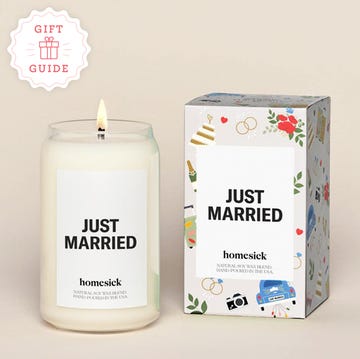
The Best Honeymoon Gifts for New Couples
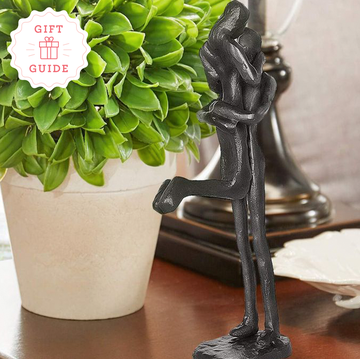
The Best 6-Year Wedding Anniversary Gifts

Anniversary Quotes That Celebrate All Love
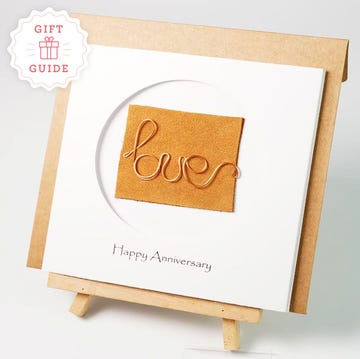
The Best Gift Ideas for Your Seventh Anniversary
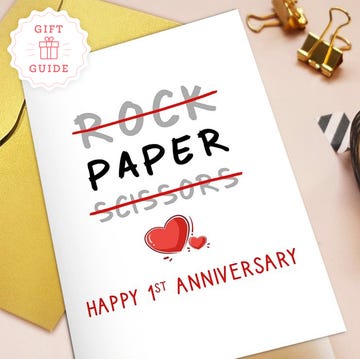
The 36 Best 1-Year Anniversary Gifts

The Best Bachelorette Party Destinations

32 Best 3-Year Anniversary Gifts

Here's What to Write in a Wedding Card
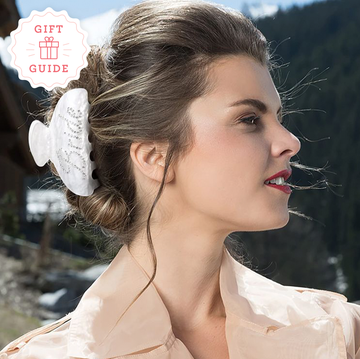
The Best Bachelorette Gift Ideas

IMAGES
VIDEO
COMMENTS
Cue * or note cards, used by speakers when making an extemporaneous speech *, are typically handheld. They are about 4 inches by 6 inches in size, with carefully selected and ordered words and phrases written on them. These act as prompt to help speakers remember what they have to say. *A cue is a signal or a prompt to say or do something.
The Purpose of Speaker Notes. Using notes adds to your credibility as a speaker. If you depend on a full manuscript to get through your delivery, your listeners might believe you don't know the content of your speech. Second, the temptation to read the entire speech directly from a manuscript, even if you're only carrying it as a safety net ...
Full Playlist: https://www.youtube.com/playlist?list=PLLALQuK1NDrgwpES8nSyafhfg6MOAhk7k--Watch more Public Speaking Training videos: http://www.howcast.com/v...
Cut and glue them onto your notes or print them directly by using the "Size" option in the "Print Layout" tab. 4. Include brief details under the keywords. Follow the keywords with the details you need to express in your speech. Create bullet points or numbering beneath the words.
Realize that notes are just notes, and shouldn't be the full manuscript of your speech. Cue cards can be very effective when speaking in public. Make sure you are writing down keywords and phrases to remember. Try not to look down at your cards too much. There are many benefits and also tricks to using notes during your speech.
Anchor that elbow to your waist and hold your notes firmly, with limited movement. Use your other hand to gesture. Don't gesture with the hand holding your notes--the flapping paper or pile of ...
Use 3x5 note cards and write on only one side of the cards. Use visual cues to help divide up information. If your speech has been outlined, use those indicators to set up the organization of your cards. Use fewer words. Just write enough to jog your memory.
Cue cards, also known as note cards, contain either the key points of a speech (or the entire text) to help a speaker stay on track or jog the memory if the speaker has not memorized the speech.They can help the speaker pace their talk for extemporaneous speeches. If you've ever given a speech or presentation and forgotten what you intended to say or in what order you wanted to make your ...
as to write up cue cards - the 3-step process go get from a speech outline to cue maps that work an way you crave them to how to iterate with hint cards; the difference between cue cards and flashlight cards; What are cue cards? Cue* or note cards, used by speakers when take an extemporaneous speech*, been typically handheld. They been about 4 ...
How to Create Note Cards in a Presentation. Note cards are typically built on index cards. The sizes vary. But a standard size for a presentation is 3×5. Once you have the cards, identify the ...
Use the same technology, presentation aids, notecards and/or tangible props. Use a timer - consider writing the time on your note cards to keep yourself on track with the pace of your speech. Allow plenty of revision and edit time - practicing for hours the night before your speech is not a successful strategy.
This video offers some advice on using notecards during the types of speeches often given in public speaking classes.
In the first method, you can print out a set of "notes pages" which combine the slide content with your notes content. In the second method, you can use "Presenter View" to display your slides for the audience and, simultaneously, your slides and notes for you. For a well-rehearsed speaker, this can work very well.
1: Outline Your Thoughts and Ideas. The first step in using note cards effectively is to utilize them as a way to organize your thoughts and ideas. Start by writing out the main points you want to cover during your presentation on individual cards, along with any key facts or figures that need to be included.
Learn how to prepare speech note cards from media coach TJ Walker in this Howcast public speaking video. Here's some tips on how to outline your speech. For starters, you don't want to just write and write and write 58 pages of PowerPoint. That's too much to even start from. What you should do is brainstorm on every single distinct idea or ...
6. During the speech, rest the notes on a lectern or table: Try not to hold them in your hand, otherwise they may reveal your shaky hands or you may subconsciously start to play with the paper. Also, feel free to move around the stage, away from the lectern. It creates a better connection with your audience and you can always walk back to your ...
Bleak or blue ink works best. If you have bad cursive, you canister type out your cash. Cut press glue them onto your notes or print them directly by using the "Size" option in the "Print Layout" tab. 4. Include brief details under the keywords. Follow the keywords with the details you need to express by you speech.
Once you become familiar with your content, try these tips for using notes appropriately. 1) Skip note cards. Note cards don't work for two simple reasons: your text will be too small to glance at quickly (keyword quickly) and you have to hold them in your hands. If you're feeling extra nervous, your hands will likely shake, waving those ...
Your hands are sweaty. Your legs feel shaky. You're light-headed. Now step up to the lectern and give your speech. Because you prepared ahead of time by creating well-formatted, informative speech note cards, you can overcome these jitters and deliver your speech, knowing you won't forget any of the important ...
Strive to write six to eight key word lines on each note card. b. Write out the full speech so you don't skip key information. c. Limit the number of cards by writing notes on both sides. d. Place numbers on the cards to keep the proper sequence. d. Place numbers on the cards to keep the proper sequence. In his speech, Tomas needs to inform the ...
At first, add necessary points to the note cards and also write number on the left corner like one, two, three etc, in order to keep them in a proper sequence. 2. The numbering on note cards will help you to re-arrange them if you ever lose their sequence. 3. You should write "Introduction" at the top of your first note card and also ...
Study with Quizlet and memorize flashcards containing terms like Most speech instructors prepare students for speeches by A) preventing them from speaking until the final day of class. B) getting them in front of a group to practice as soon as possible. C) preventing them from speaking until they have perfected their form. D) having them deliver a long, detailed speech as a first assignment ...
Go to the Record tab. Tap "Presentation" or "Meeting". Tap "Add notecards" to start building your notecard stack. And that's it! When you start your recording, your notecards will appear on the screen. You can navigate forward and backward through your notecard stack. You can also pause the recording and edit the notecards—super ...
Tip #1: Read Inspirational Quotes. Reading inspirational quotes is a great way to start brainstorming graduation speech ideas. The best quotes can pack a whole speech into only a sentence or two. Here are a few examples to get the fire of inspiration started: "The two most important days in your life are the day you are born and the day you ...
Conclusion. Master your moment with a graduation speech that turns heads and warms hearts. Remember the power of gratitude and connect with your audience through stories, those shared adventures that bind you to your classmates. Don't be afraid to add a few jokes and quotes to your speech either, as well as personal growth stories to inspire.
18. Short and Sweet Note. This end-of-year letter template's design is perfect for a short and sweet message to elementary students. Get the free Google Doc template for this letter and two others when you fill out the form on this landing page. Get Free Note Template.
May this day be the start of forever for you two. May your love burn brighter every day as you grow in love. Wishing you a lifetime of love and happiness. Always remember this special day and why ...
Sympathy card messages for acquaintances. Healing Tears. Blue & White. Wishing You Peace Sympathy Fruit Gift Basket. Heavenly Angels. Wind Chimes. I'm so sorry to hear of your loss. Wishing you peace during this difficult time. Our thoughts and prayers are with you and your family.
Typing notes on your computer is convenient, but consider that research has shown - for those who are able to do so - that we learn better when we write notes by hand. When we write notes by hand, we transcribe less and interpret more. In other words, we do not write down the instructor's words verbatim, but rather we put the concepts in ...
Wishing you all the love as you prep for your wife era! Best wishes for a lifetime of happiness together. Here's to a joyous life together as you embark upon this love-filled journey. May the ...